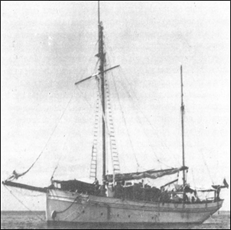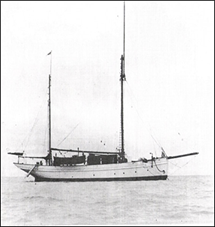| MICHAEL A. “MIKE”
MASTERS |
|
|
|
|
|
|
|
|
|
|
|
|
|
|
|
| [Mr.
Masters has given special permission to use portions of Once
A Marine Always A Marine (1988), his wartime
memoirs, to serve as the basis of this report for the Living Tarawa Veterans
Roster. His gesture is most
appreciated.] |
|
|
|
|
|
|
|
|
|
|
|
|
|
|
|
|
|
|
|
|
|
|
|
| My
hometown was Chicago, and my parents’ house was really close to the Municipal
Airport. I graduated from high school
in June 1939. With a strong interest
in the U.S. Marine Corps and a similar interest in aviation, I enlisted in
the U.S. Marine Corps on 24 July 1939, a time when the Corps was an elite
military organization of about 18,000 active-duty men. Entry requirements were stringent, higher
than the other services, and all of that appealed immensely to me, to do my
best and be with the best in the service of our country. |
|
|
|
|
|
|
|
|
|
|
|
|
|
|
|
| With
$6.10 in my pocket for meals, I was sent by train to the Marine Corps Recruit
Depot in San Diego for boot camp. |
|
|
|
|
|
|
|
|
|
|
|
|
|
|
|
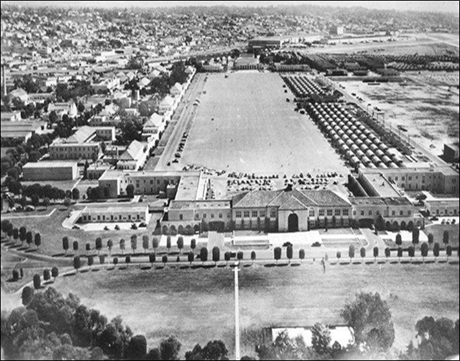
|
|
|
|
|
|
|
|
|
|
|
|
|
|
|
|
|
|
|
|
|
|
|
|
|
|
|
|
|
|
|
|
|
|
|
|
|
|
|
|
|
|
|
|
|
|
|
|
|
|
|
|
|
|
|
|
|
|
|
|
|
|
|
|
|
|
|
|
|
|
|
|
|
|
|
|
|
|
|
|
|
|
|
|
|
|
|
|
|
|
|
|
|
|
|
|
|
|
|
|
|
|
|
|
|
|
|
|
|
|
|
|
|
|
|
|
|
|
|
|
|
|
|
|
|
|
|
|
|
|
|
|
|
|
|
|
|
|
|
|
|
|
|
|
|
|
|
|
|
|
|
|
|
|
|
|
|
|
|
|
|
|
|
|
|
|
|
|
| Marine
Corps Recruiting Depot in San Diego, as Mike knew it |
|
|
|
|
|
|
|
| http://www.grunt.com/corps/uploads/stories/quonsethuts.jpg |
|
|
|
|
|
|
|
|
|
|
|
|
|
|
|
| Training
was as tough as any Marine boot will tell you. “Boots,” as recruits were called, went
through strict and demanding training and indoctrination procedures: the GI haircut; receiving a bucket of
toilet articles (including a bag of Bull Durham tobacco and paper since we
were not allowed brand cigarettes); summer khaki uniforms and blue cover-all
fatigues (the kind farmers wore); olive-green dress uniforms, with Marine emblems;
two pairs of ankle-high shoes that laced up; tropical pith helmet; World War
I steel helmet and army pack; and finally, a ‘03 Springfield bolt-action
rifle still covered with cosmoline grease. |
|
|
|
|
|
|
|
|
|
|
|
|
|
|
|
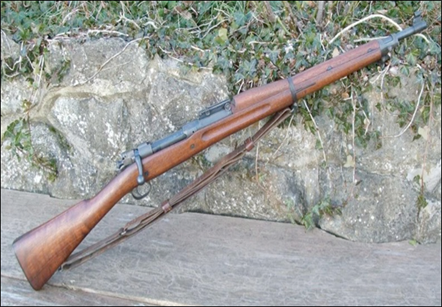
|
|
|
|
|
|
|
|
|
|
|
|
|
|
|
|
|
|
|
|
|
|
|
|
|
|
|
|
|
|
|
|
|
|
|
|
|
|
|
|
|
|
|
|
|
|
|
|
|
|
|
|
|
|
|
|
|
|
|
|
|
|
|
|
|
|
|
|
|
|
|
|
|
|
|
|
|
|
|
|
|
|
|
|
|
|
|
|
|
|
|
|
|
|
|
|
|
|
|
|
|
|
|
|
|
|
|
|
|
|
|
|
|
|
|
|
|
|
|
|
|
|
|
|
|
|
|
|
|
|
|
|
|
|
|
|
|
|
|
|
|
|
|
|
| US
Model 1903 Springfield rifle, caliber .30-06 |
|
|
|
|
|
|
|
| http://www.nps.gov/spar/historyculture/the-1903-springfield-rifle.htm |
|
|
|
|
|
|
|
|
|
|
|
|
|
|
|
| We
were taught that our rifle was always our own personal responsibility
wherever we went. “You are a Marine
first! That rifle is now a part of you
and is the only friend you
have. Your life may depend upon it
some day!” For mistreatment or
improper use of our rifle, penalties were severe. Simply by accidentally calling our rifle a
gun could cause swift and very humiliating repercussions when drill
instructors corrected such inappropriate use of the language in front of
fellow boots. Witnessing a drill
instructor’s tirade on a poor boot was a lesson we definitely remembered! |
|
|
|
|
|
|
|
|
|
|
|
|
|
|
|
| In
August 1939, I graduated from boot camp in the 24th Platoon, and that opened doors to a number of specialized
career opportunities. I chose the
prestigious three-week Sea School and, ultimately, was assigned to the
battleship USS Tennessee (BB-43). Some of my
Sea School graduates were assigned to the USS Arizona which was sunk some two years later when the Japanese
attacked Pearl Harbor, and I will never forget those men. |
|
|
|
|
|
|
|
|
|
|
|
|
|
|
|
| Some of
the others from my recruit class were sent to defense battalions on Wake,
Midway and Guam where they made history defending those islands against
Japanese landings. Those who survived
on Wake and Guam and were sent as prisoners to Japan. |
|
|
|
|
|
|
|
|
|
|
|
|
|
|
|
| I
left the Tennessee in
mid-November 1941 and was on liberty at home in Chicago when my mother told
me she had heard a radio report that some Imperial Japanese Navy vessels had
left the Inland Sea for unspecified destinations. Something very ominous seemed to be
underway by the Japanese! |
|
|
|
|
|
|
|
|
|
|
|
|
|
|
|
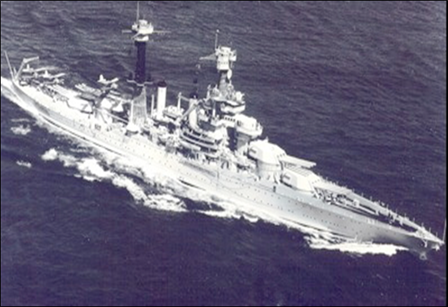
|
|
|
|
|
|
|
|
|
|
|
|
|
|
|
|
|
|
|
|
|
|
|
|
|
|
|
|
|
|
|
|
|
|
|
|
|
|
|
|
|
|
|
|
|
|
|
|
|
|
|
|
|
|
|
|
|
|
|
|
|
|
|
|
|
|
|
|
|
|
|
|
|
|
|
|
|
|
|
|
|
|
|
|
|
|
|
|
|
|
|
|
|
|
|
|
|
|
|
|
|
|
|
|
|
|
|
|
|
|
|
|
|
|
|
|
|
|
|
|
|
|
|
|
|
|
|
|
|
|
|
|
|
|
|
|
|
|
|
|
|
|
|
|
| USS Tennessee (BB-43) |
|
|
|
|
|
|
|
| Mike
Master’s ‘home’ between mid-October 1939 and mid-November 1941 |
|
|
|
|
|
|
|
| Courtesy: permission to use above photo from Bill
McWilliams (USAF, Colonel, Ret), |
|
|
|
|
|
|
|
| author
of SUNDAY IN HELL: Pearl Harbor Minute by Minute (2011); |
|
|
|
|
|
|
|
| http://www.west-point.org/class/usma1955/D/M/PHP.htm |
|
|
|
|
|
|
|
|
|
|
|
|
|
|
|
| Little
did anybody know or even predict at that time that within three weeks some
Japanese aircraft carriers would launch aircraft onto unsuspecting US Navy
ships at Pearl Harbor. That attack,
which severely but partially crippled operational capabilities of the US
Pacific fleet stationed there and resulted in the deaths of nearly 2,400
people, was what triggered America’s declaration of war against Imperial
Japan. My former ‘home at sea,’ the Tennessee, was damaged but
returned to duty almost eight months later and valiantly earned 10 battle
stars before the war ended. I have had
many occasions to contemplate what I missed by being transferred from the Tennessee so shortly before the
attack on Pearl Harbor. |
|
|
|
|
|
|
|
|
|
|
|
|
|
|
|
| My
liberty in Chicago was finished very shortly before the Japanese attack on
Pearl Harbor, and I returned to the West Coast for several weeks to Yerba
Buena Island (where the San Francisco Bay Bridge is anchored on its route
between San Francisco and Oakland, California) to wait for my next
assignment. |
|
|
|
|
|
|
|
|
|
|
|
|
|
|
|
| In
February 1942, orders came and I left Yerba Buena to go to the Marine base in
San Diego. Expecting to be transported
to the docks to waiting transports, we instead headed east across the Bay
Bridge to Oakland, to an old secluded railway station which had obviously not
been used in years. With secrecy and
urgency, we boarded a troop train whose cars looked as if they hadn’t been
used since World War I. They had none
of the comforts anybody would associate with passenger coaches. They were converted steel boxcars with
several square windows and a plain square door on each side. Each car had a mixture of hard seats and
benches, with a head at each end. Not
surprisingly, these cars were called “cattle cars.” |
|
|
|
|
|
|
|
|
|
|
|
|
|
|
|
| In
San Diego, I was eventually assigned to a platoon of assault engineers in
Company D, 2nd
Battalion, 18th Marine Regiment (Pioneers), attached to the 2nd Marine
Division. [Mike’s 2nd Battalion was the 2nd Combat Engineer
Battalion whose mission was to “enhance the mobility, counter mobility, and
survivability of the Marine Division through combat and limited engineering
support.” |
|
|
|
|
|
|
|
| http://www.2ndmardiv.marines.mil/Units/2ndCombatEngineerBN.aspx |
|
|
|
|
|
|
|
| https://en.wikipedia.org/wiki/2nd_Combat_Engineer_Battalion |
|
|
|
|
|
|
|
|
|
|
|
|
|
|
|
| By
June 1942, I was on my way to the Solomon Islands on the USS President Hayes (APA-20) where, beginning on 7 August, I
was part of America’s first ground offensive of World War II. The next day I
was in the landings on Tulagi Island, very close to Florida Island. Actually, our landing was at a village
named Sesapi which later became the Patrol Boat (PT) base from which our
future president John F. Kennedy operated for a while. |
|
|
|
|
|
|
|
| http://www.history.navy.mil/danfs/p/PT-109.htm |
|
|
|
|
|
|
|
|
|
|
|
|
|
|
|
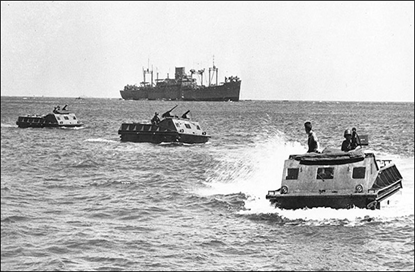
|
|
|
|
|
|
|
|
|
|
|
|
|
|
|
|
|
|
|
|
|
|
|
|
|
|
|
|
|
|
|
|
|
|
|
|
|
|
|
|
|
|
|
|
|
|
|
|
|
|
|
|
|
|
|
|
|
|
|
|
|
|
|
|
|
|
|
|
|
|
|
|
|
|
|
|
|
|
|
|
|
|
|
|
|
|
|
|
|
|
|
|
|
|
|
|
|
|
|
|
|
|
|
|
|
|
|
|
|
|
|
|
|
|
|
|
|
|
|
|
|
|
|
|
|
|
|
|
| USS President Hayes (APA-39), during
Guadalcanal landings 7-9 August 1942 |
|
|
|
|
|
|
|
| http://www.history.navy.mil/photos/sh-usn/usnsh-p/ap39.htm |
|
|
|
|
|
|
|
| http://www.history.navy.mil/photos/events/wwii-pac/guadlcnl/guad-1.htm |
|
|
|
|
|
|
|
|
|
|
|
|
|
|
|
| Notable
“firsts” in that operation included the first bayonet charge by Marines on
the causeway linking Gavutu and Tanambogo Islands (across Sealark Channel
from Guadalcanal) and the first American offensive use of artillery in World
War II. |
|
|
|
|
|
|
|
|
|
|
|
|
|
|
|
| As
Mike says, “To this day, the Japanese call the island of Guadalcanal “The
Island of Death,” where Marines and attached units inflicted more than 27,000
casualties, at a cost of more than 8,000 Marines and soldiers. Of this amount, 2,484 Marines were killed
or were missing. The slim victories of
the Marines were due to their discipline, training, and ability to withstand
hunger, fatigue, and disease” -- qualities that made all the difference in
subsequent Marine victories across the Pacific. |
|
|
|
|
|
|
|
|
|
|
|
|
|
|
|
| In
late January 1943, I boarded the USS President Adams (APA-19) bound for New Zealand. There, because of the combat at
Guadalcanal, Marine units were rebuilt to fighting strength, equipment was
replaced and some new equipment was handed out, and we routinely went through
extensive training prior to our next combat assignment. |
|
|
|
|
|
|
|
|
|
|
|
|
|
|
|
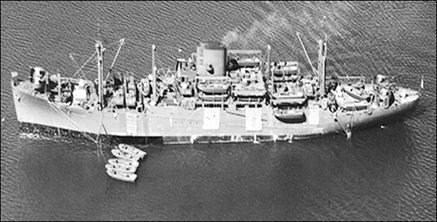
|
|
|
|
|
|
|
|
|
|
|
|
|
|
|
|
|
|
|
|
|
|
|
|
|
|
|
|
|
|
|
|
|
|
|
|
|
|
|
|
|
|
|
|
|
|
|
|
|
|
|
|
|
|
|
|
|
|
|
|
|
|
|
|
|
|
|
|
|
|
|
|
|
|
|
|
|
|
|
|
|
|
|
|
|
|
|
|
|
|
|
|
|
|
|
|
|
|
|
|
|
|
|
|
| USS President Adams (APA-19) |
|
|
|
|
|
|
|
| http://www.ibiblio.org/hyperwar/USN/ships/APA/APA-19_PresidentAdams.html |
|
|
|
|
|
|
|
|
|
|
|
|
|
|
|
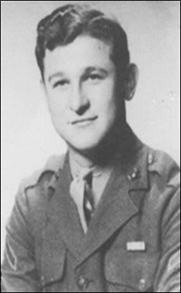
|
|
|
|
|
|
|
|
|
|
|
|
|
|
|
|
|
|
|
|
|
|
|
|
|
|
|
|
|
|
|
|
|
|
|
|
|
|
|
|
|
|
|
|
|
|
|
|
|
|
|
|
|
|
|
|
|
|
|
|
|
|
|
|
|
|
|
|
|
|
|
|
|
|
|
|
|
|
|
|
|
|
|
|
|
|
|
|
|
|
|
|
|
|
|
|
|
|
|
|
|
|
|
|
|
|
|
|
|
|
|
|
|
|
|
|
|
|
|
|
|
|
|
|
|
|
|
|
|
|
|
|
|
|
|
|
| Mike
Masters |
|
|
|
|
|
|
|
| 1943 |
|
|
|
|
|
|
|
|
|
|
|
|
|
|
|
| After a
nine-month stay in New Zealand (which Mike fondly refers to as his “Home Away
from Home”), the next engagement for Mike and the 2nd Marine Division was Operation
Galvanic at Tarawa Atoll in the Gilbert
Islands. That topic becomes the
primary focus of this report on Mike Masters. |
|
|
|
|
|
|
|
|
|
|
|
|
|
|
|
| T A R
A W A |
|
|
|
|
|
|
|
| Seventy-Two
Hours of Hell |
|
|
|
|
|
|
|
|
|
|
|
|
|
|
|
| It was
late October 1943 and I was 21 years old.
The Battle of Guadalcanal was already in my rear view mirror, and I
had grown up fast. Our memorable stay in New Zealand was fast drawing to a
close. With new replacements, new M1
semi-automatic rifles, flamethrowers, training, training, and more training,
the men of our company were in top physical condition, ready and equipped to
take on the Japs. |
|
|
|
|
|
|
|
|
|
|
|
|
|
|
|
| Troops
and equipment were now thoroughly molded into an invincible fighting
force. The time had come; our
transports were waiting in Wellington Harbor to take us on “practice”
landings. Our platoon was again
detached, and we joined our battalion aboard the troop transport, USS Sheridan (APA-51). We were in Task Force 53.1.2 commanded by
Captain J.B. McGovern, USN. Besides
our own transport, this group of vessels included the Monrovia, Doyen, Virgo, La Salle and the Ashland. |
|
|
|
|
|
|
|
| http://usssheridanapa51.com/ |
|
|
|
|
|
|
|
| http://pacific.valka.cz/forces/tf53.htm#galvan |
|
|
|
|
|
|
|

|
|
|
|
|
|
|
|
|
|
|
|
|
|
|
|
|
|
|
|
|
|
|
|
|
|
|
|
|
|
|
|
|
|
|
|
|
|
|
|
|
|
|
|
|
|
|
|
|
|
|
|
|
|
|
|
|
|
|
|
|
|
|
|
|
|
|
|
|
|
|
|
|
|
|
|
|
|
|
|
|
|
|
|
|
|
|
|
|
|
|
|
|
|
|
|
|
|
|
|
|
|
|
|
|
|
|
|
|
|
|
|
| USS Sheridan (APA-51) |
|
|
|
|
|
|
|
| http://www.usssheridanapa51.com/ |
|
|
|
|
|
|
|
|
|
|
|
|
|
|
|
| I
was the NCO of a squad-sized shore party reconnaissance team that was part of
Company D, 2nd Battalion (Pioneers), 18th Marines. We were
assigned to land with the assault waves.
Word was purposely released that the transports were proceeding north
along the coast to Hawkes Bay for landing exercises and that our heavy
equipment would then be transported by rail back to the camps. This ruse may have fooled Tokyo Rose, but
it didn’t fool this “old salt” from Chicago. |
|
|
|
|
|
|
|
|
|
|
|
|
|
|
|
| In
fact, practice landings did occur up on the north end of Hawkes Bay, at a
place called Mahia Bay. Just a few days prior to the 70th anniversary of the 2nd Marine Division’s practice landings in November 1943, members
of the New Zealand Military Vehicle Collectors Club (Robin Beale, current
president) held an event to commemorate our Marines’ original practice
landings. |
|
|
|
|
|
|
|
|
|
|
|
|
|
|
|
| The
four photographs below relate to the ceremony held on 27 October 2013 -
almost 70 years after our first stop there.
Three Marines from Camp Pendleton were flown out to New Zealand for
the ceremony. These Marines and one of
the US Embassy staff (wearing the red lapel poppy) were the guests of our
friends in New Zealand. At the far
right of this photo is an American flag draped over a rock cairn, covering a
plaque installed there by the people of New Zealand. At the appropriate moment during the
ceremony, our flag was lifted from the cairn and the new memorial plaque was
present for everybody to see. |
|
|
|
|
|
|
|
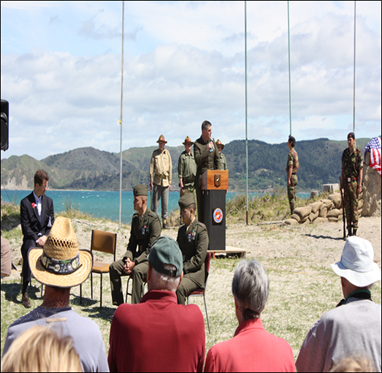
|
|
|
|
|
|
|
|
|
|
|
|
|
|
|
|
|
|
|
|
|
|
|
|
|
|
|
|
|
|
|
|
|
|
|
|
|
|
|
|
|
|
|
|
|
|
|
|
|
|
|
|
|
|
|
|
|
|
|
|
|
|
|
|
|
|
|
|
|
|
|
|
|
|
|
|
|
|
|
|
|
|
|
|
|
|
|
|
|
|
|
|
|
|
|
|
|
|
|
|
|
|
|
|
|
|
|
|
|
|
|
|
|
|
|
|
|
|
|
|
|
|
|
|
|
|
|
|
|
|
|
|
|
|
|
|
|
|
|
|
|
|
|
|
|
|
|
|
|
|
|
|
|
|
|
|
|
|
|
|
|
|
|
|
|
|
|
|
|
|
|
|
|
|
|
|
|
|
|
|
|
|
|
|
| New
Zealanders and guests from the US Marines and the American Embassy meet on
Mahia Bay |
|
|
|
|
|
|
|
| to
again thank our New Zealand hosts 70+ years ago prior to the unveiling of a
plaque commemorating our original practice landings there in early November
1943. |
|
|
|
|
|
|
|
| Courtesy: Robin Beale and Kevin Simmonds |
|
|
|
|
|
|
|
|
|
|
|
|
|
|
|
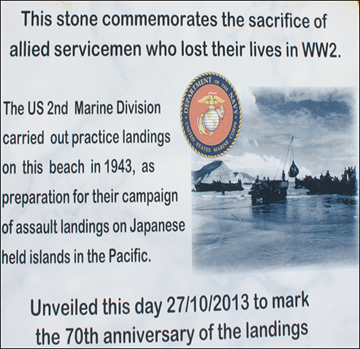
|
|
|
|
|
|
|
|
|
|
|
|
|
|
|
|
|
|
|
|
|
|
|
|
|
|
|
|
|
|
|
|
|
|
|
|
|
|
|
|
|
|
|
|
|
|
|
|
|
|
|
|
|
|
|
|
|
|
|
|
|
|
|
|
|
|
|
|
|
|
|
|
|
|
|
|
|
|
|
|
|
|
|
|
|
|
|
|
|
|
|
|
|
|
|
|
|
|
|
|
|
|
|
|
|
|
|
|
|
|
|
|
|
|
|
|
|
|
|
|
|
|
|
|
|
|
|
|
|
|
|
|
|
|
|
|
|
|
|
|
|
|
|
|
|
|
|
|
|
|
|
|
|
|
|
|
|
|
|
|
|
|
|
|
|
|
|
|
| New
Zealand’s memorial plaque commemorating our Marines |
|
|
|
|
|
|
|
| Courtesy:
Robin Beale and Kevin Simmonds |
|
|
|
|
|
|
|
|
|
|
|
|
|
|
|
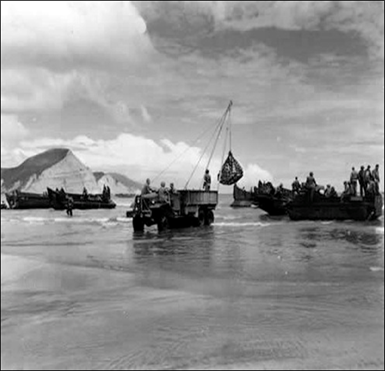
|
|
|
|
|
|
|
|
|
|
|
|
|
|
|
|
|
|
|
|
|
|
|
|
|
|
|
|
|
|
|
|
|
|
|
|
|
|
|
|
|
|
|
|
|
|
|
|
|
|
|
|
|
|
|
|
|
|
|
|
|
|
|
|
|
|
|
|
|
|
|
|
|
|
|
|
|
|
|
|
|
|
|
|
|
|
|
|
|
|
|
|
|
|
|
|
|
|
|
|
|
|
|
|
|
|
|
|
|
|
|
|
|
|
|
|
|
|
|
|
|
|
|
|
|
|
|
|
|
|
|
|
|
|
|
|
|
|
|
|
|
|
|
|
|
|
|
|
|
|
|
|
|
|
|
|
|
|
|
|
|
|
|
|
|
|
|
|
|
|
|
|
|
|
|
|
| 70-year
old photo of our Marines’ mock landings at Mahia Bay, November 1943 |
|
|
|
|
|
|
|
| Courtesy: Robin Beale |
|
|
|
|
|
|
|
| http://www.nzhistory.net.nz/media/photo/mock-landing-at-mahia |
|
|
|
|
|
|
|
| http://nzmvcc.org.nz/ |
|
|
|
|
|
|
|
|
|
|
|
|
|
|
|
| If
only our Marines had had the beauty and tranquility of the Hawkes Bay area
when they finally reached their still unannounced destination later in
November 1943! |
|
|
|
|
|
|
|
|
|
|
|
|
|
|
|
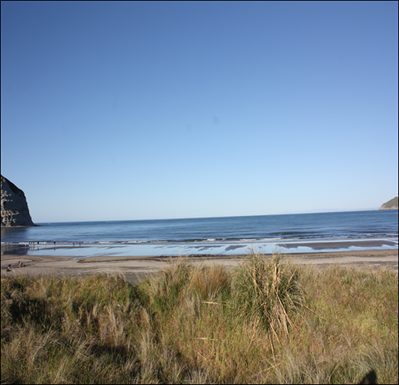
|
|
|
|
|
|
|
|
|
|
|
|
|
|
|
|
|
|
|
|
|
|
|
|
|
|
|
|
|
|
|
|
|
|
|
|
|
|
|
|
|
|
|
|
|
|
|
|
|
|
|
|
|
|
|
|
|
|
|
|
|
|
|
|
|
|
|
|
|
|
|
|
|
|
|
|
|
|
|
|
|
|
|
|
|
|
|
|
|
|
|
|
|
|
|
|
|
|
|
|
|
|
|
|
|
|
|
|
|
|
|
|
|
|
|
|
|
|
|
|
|
|
|
|
|
|
|
|
|
|
|
|
|
|
|
|
|
|
|
|
|
|
|
|
|
|
|
|
|
|
|
|
|
|
|
|
|
|
|
|
|
|
|
|
|
|
|
|
|
|
|
|
|
|
|
|
|
|
|
|
|
|
|
|
| Mahia
Bay on Hawkes Bay, North Island, New Zealand |
|
|
|
|
|
|
|
| Courtesy:
Robin Beale and Kevin Simmonds |
|
|
|
|
|
|
|
|
|
|
|
|
|
|
|
| Amphibious
maneuvers at Hawkes Bay maneuvers went off smoothly. The New Zealand Air Force assisted with
simulated air cover while the waters churned with boats hitting the beach all
day. That evening, all boats and even
the heavy equipment were ordered back to their transports for
re-embarking. Just as we left San
Diego a year prior, ships got underway, formed a staggered convoy flanked by
escort destroyers, and headed in a northerly direction, not south back to
Wellington. |
|
|
|
|
|
|
|
|
|
|
|
|
|
|
|
| After
several hours of sailing, the chilling word came over the ship’s
speakers: “To all Marines: We are not returning to our camps. This convoy is now proceeding into
combat. Our destination and plans will
be announced in a few days.” Several
days later our convoy arrived off Efate in the New Hebrides for another day
of landing exercises with other units of the fleet. That evening the transports anchored within
the harbor while Marine and Naval commanders held a final meeting. |
|
|
|
|
|
|
|
|
|
|
|
|
|
|
|
| After
Mike Masters' report was finished, supplementary information indicated where
he and his unit were for the few days at Efate Island. Sheridan went into Havannah Harbor up on Efate's northwest coast. |
|
|
|
|
|
|
|
|
|
|
|
|
|
|
|
| “SHERIDAN
arrived in Noumea, New Caledonia on 18 October 1943, debarked her troops, and
commenced unloading her cargo. She
sailed to Lamberton Harbor, Wellington, New Zealand on 21st, and on 1 November, sailed for Havannah Harbor, Efate Island,
New Hebrides in company with the battleship USS MARYLAND, and attack
transport USS MONROVIA.” |
|
|
|
|
|
|
|
| History of USS Sheridan (APA 51). Division of Naval History, Ships’
Histories Section,
Navy Department, 1952. http://usssheridanapa51.com/Sheridan_History.pdf |
|
|
|
|
|
|
|
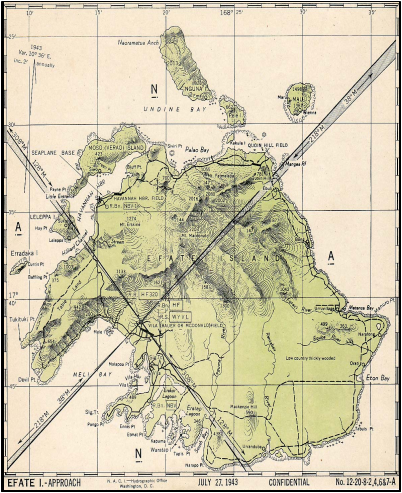
|
|
|
|
|
|
|
|
|
|
|
|
|
|
|
|
|
|
|
|
|
|
|
|
|
|
|
|
|
|
|
|
|
|
|
|
|
|
|
|
|
|
|
|
|
|
|
|
|
|
|
|
|
|
|
|
|
|
|
|
|
|
|
|
|
|
|
|
|
|
|
|
|
|
|
|
|
|
|
|
|
|
|
|
|
|
|
|
|
|
|
|
|
|
|
|
|
|
|
|
|
|
|
|
|
|
|
|
|
|
|
|
|
|
|
|
|
|
|
|
|
|
|
|
|
|
|
|
|
|
|
|
|
|
|
|
|
|
|
|
|
|
|
|
|
|
|
|
|
|
|
|
|
|
|
|
|
|
|
|
|
|
|
|
|
|
|
|
|
|
|
|
|
|
|
|
|
|
|
|
|
|
|
|
|
|
|
|
|
|
|
|
| A WWII
US Navy Seabee map of Efate Island, New Hebrides |
|
|
|
|
|
|
|
| NOTE: Havannah Harbor on northwest coast; Mele
Bay on southwest coast |
|
|
|
|
|
|
|
| https://en.wikipedia.org/wiki/File:Map_of_approach_to_Efate_Island.jpg |
|
|
|
|
|
|
|
|
|
|
|
|
|
|
|
| Our
stop basically served at least three purposes: waiting for more vessels to join our
convoy; practicing more amphibious landings at Mele Bay while waiting for
those additional vessels; and refueling Sheridan and resupplying the troops on board. |
|
|
|
|
|
|
|
|
|
|
|
|
|
|
|
| Good
planning and logistics made Havannah Harbor a good and practical place to be
at this time for our convoy. For at
least 18 months prior to our arrival at Havannah Harbor, the US Army and,
eventually, US Navy Seabees had been constructing port and airfield
facilities at Havannah Harbor.
Initiated by the 101st Engineer Regiment of the US Army's Americal Division and completed by
US Navy Seabees, this work gave the US Navy a support base that increasingly
enabled its warfare strategy in the South and Western Pacific. The first tough test of this build up was
the Navy's costly but ultimately successful performance in the nearby Battle
of the Coral Sea in May 1942. |
|
|
|
|
|
|
|
| http://www.ibiblio.org/hyperwar/USN/Building_Bases/bases-24.html |
|
|
|
|
|
|
|
| http://americal.org/about.html |
|
|
|
|
|
|
|
| Cronin,
Francis. Under The Southern Cross: The Saga of the
Americal Division. Boston: Americal Division Veterans
Association, 1978. 15-16, 31-32. |
|
|
|
|
|
|
|
|
|
|
|
|
|
|
|
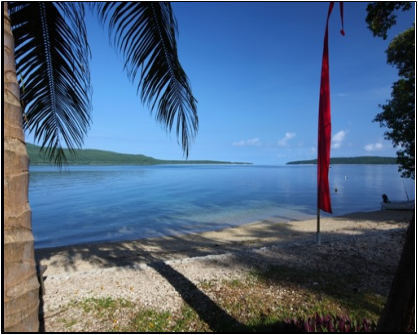
|
|
|
|
|
|
|
|
|
|
|
|
|
|
|
|
|
|
|
|
|
|
|
|
|
|
|
|
|
|
|
|
|
|
|
|
|
|
|
|
|
|
|
|
|
|
|
|
|
|
|
|
|
|
|
|
|
|
|
|
|
|
|
|
|
|
|
|
|
|
|
|
|
|
|
|
|
|
|
|
|
|
|
|
|
|
|
|
|
|
|
|
|
|
|
|
|
|
|
|
|
|
|
|
|
|
|
|
|
|
|
|
|
|
|
|
|
|
|
|
|
|
|
|
|
|
|
|
| Early
morning view to the west at Havannah Harbor, Efate Island |
|
|
|
|
|
|
|
| www.treesandfishes.com |
|
|
|
|
|
|
|
|
|
|
|
|
|
|
|
| Only
a few of the high echelon commanders knew what the next target would be. Scuttlebutt was that it might be Wake
Island. We were excited to think that
we may be chosen to avenge our valiant counterparts--those Marines who held
off Japanese forces for sixteen days while dealing them a severe blow. The Battle of Wake Island began the same
day as Japanese forces attacked Pearl Harbor, on 7 December 1941, and lasted
until Marines were overwhelmed and forced to surrender on 23 December
1941. American POWs from the defense
of Wake Island faced extreme maltreatment, including starvation, denial of
medical treatment, whippings and beheadings. |
|
|
|
|
|
|
|
| http://www.historynet.com/wake-island-prisoners-of-world-war-ii.htm |
|
|
|
|
|
|
|
|
|
|
|
|
|
|
|
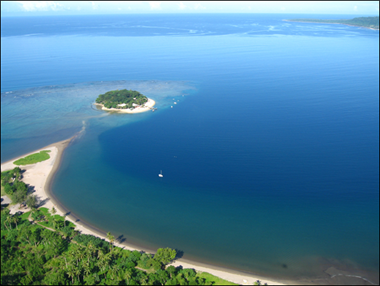
|
|
|
|
|
|
|
|
|
|
|
|
|
|
|
|
|
|
|
|
|
|
|
|
|
|
|
|
|
|
|
|
|
|
|
|
|
|
|
|
|
|
|
|
|
|
|
|
|
|
|
|
|
|
|
|
|
|
|
|
|
|
|
|
|
|
|
|
|
|
|
|
|
|
|
|
|
|
|
|
|
|
|
|
|
|
|
|
|
|
|
|
|
|
|
|
|
|
|
|
|
|
|
|
|
|
|
|
|
|
|
|
|
|
|
|
|
|
|
|
|
|
|
|
|
|
|
|
|
|
|
|
|
|
|
|
| Mele
Bay, Efate, New Hebrides (now, Republic of Vanuatu) |
|
|
|
|
|
|
|
| http://www.vanuatubeachbar.com/wp-content/uploads/2011/10/air-view-of-Mele-Bay.png |
|
|
|
|
|
|
|
|
|
|
|
|
|
|
|
| A few
days out of Efate and still heading north by east, officers in charge got
word over the PA horn to release all confidential information on the upcoming
campaign and what was expected of the units. |
|
|
|
|
|
|
|
|
|
|
|
|
|
|
|
| We
still thought it may be Wake, until we gathered around a relief map of a
single horseshoe-shaped island and were informed that the assault would be on
a heavily defended, small island called Betio in the Tarawa Atoll, roughly
2,400 miles southwest of the Hawaiian Islands. |
|
|
|
|
|
|
|
|
|
|
|
|
|
|
|
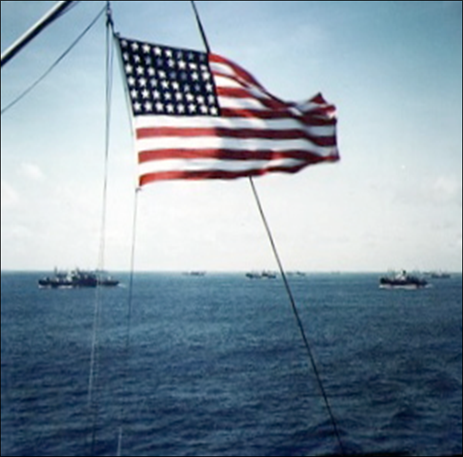
|
|
|
|
|
|
|
|
|
|
|
|
|
|
|
|
|
|
|
|
|
|
|
|
|
|
|
|
|
|
|
|
|
|
|
|
|
|
|
|
|
|
|
|
|
|
|
|
|
|
|
|
|
|
|
|
|
|
|
|
|
|
|
|
|
|
|
|
|
|
|
|
|
|
|
|
|
|
|
|
|
|
|
|
|
|
|
|
|
|
|
|
|
|
|
|
|
|
|
|
|
|
|
|
|
|
|
|
|
|
|
|
|
|
|
|
|
|
|
|
|
|
|
|
|
|
|
|
|
|
|
|
|
|
|
|
|
|
|
|
|
|
|
|
|
|
|
|
|
|
|
|
|
|
|
|
|
|
|
|
|
|
|
|
|
|
|
|
|
|
|
|
|
|
|
|
|
|
|
|
|
|
|
|
| On his
journey from Efate to Tarawa, Mike would have seen views like this. |
|
|
|
|
|
|
|
| NOTE: the 48-star “Old Glory” |
|
|
|
|
|
|
|
| http://navyvets.tripod.com/sitebuildercontent/sitebuilderpictures/wwiiconvoy.jpg |
|
|
|
|
|
|
|
|
|
|
|
|
|
|
|
| Our
intelligence estimated that the Japanese had more than 5,000 well-trained
Naval Landing Force (Imperial Marines) personnel defending Betio. The island was just a little over two miles
long and a half-mile wide, but the Japs had sufficient time to build it into
a formidable fortress bristling with machine guns, 8” dual-purpose guns,
coast artillery, and tanks, all interlaced with tank traps and open trenches. |
|
|
|
|
|
|
|
|
|
|
|
|
|
|
|
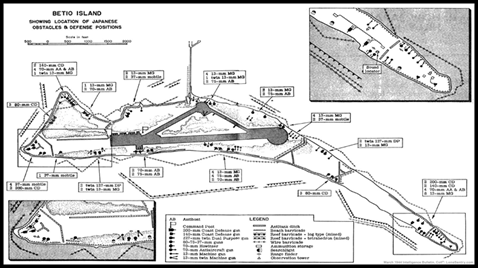
|
|
|
|
|
|
|
|
|
|
|
|
|
|
|
|
|
|
|
|
|
|
|
|
|
|
|
|
|
|
|
|
|
|
|
|
|
|
|
|
|
|
|
|
|
|
|
|
|
|
|
|
|
|
|
|
|
|
|
|
|
|
|
|
|
|
|
|
|
|
|
|
|
|
|
|
|
|
|
|
|
|
|
|
|
|
|
|
|
|
|
|
|
|
|
|
|
|
|
|
|
|
|
|
|
|
|
|
|
|
|
|
|
|
|
|
|
|
|
|
|
|
|
|
|
|
|
|
| Betio: Japanese obstacles and defense positions
thought to exist prior to attack |
|
|
|
|
|
|
|
| http://www.lonesentry.com/articles/jp-betio-island/tarawa-betio-island.jpg |
|
|
|
|
|
|
|
|
|
|
|
|
|
|
|
| While
en route, one of the transports limped back from the convoy, then a destroyer
dropped back to escort it. The next
day, we heard a rumor that the transport’s steering mechanism had jammed and
it could go only in wide circles, forcing it to reduce speed until the
problem was corrected. Next morning
the two ships caught up with the convoy.
Sailing a zigzag course within a convoy to evade preying Jap
submarines was still a hazard; any ship falling out had to take its chances
with an escort. I can imagine how
those Marines felt aboard that transport. |
|
|
|
|
|
|
|
|
|
|
|
|
|
|
|
| Most
of us took shipboard life in our strides, being veterans of the Guadalcanal
campaign. New replacements, fresh from
the States and going into combat for the first time, were apprehensive. The new men were fortunate to have this
time for indoctrination. The old salts
told them what to expect. A favorite
assurance heard was “Just stick with me, Mac!” Shipboard activities consisted of morning
calisthenics, tactical map sessions conducted by officers and NCOs, and
checking and re-checking equipment and weapons. Afternoons were generally free, because of
rising tropical temperatures. |
|
|
|
|
|
|
|
|
|
|
|
|
|
|
|
| When
we were en route to Guadalcanal, our convoy was concealed by rainsqualls
right up to the morning of the landing.
Although this convoy was much larger -- spread over hundreds of miles
-- and the weather was clear right up to reaching the target, we still
weren’t detected by Japanese patrols.
A day before the landing one of our patrol planes spotted a lone
Japanese “Betty” bomber on radar just southwest of the convoy. The surprised intruder was shot down before
he could possibly reveal any information. |
|
|
|
|
|
|
|
|
|
|
|
|
|
|
|
| [20
November: D-Day]
Our huge armada approached Tarawa … Out of curiosity, I had to see
what was going on topside. It was
still dark. Troop transports were now
in their final approaches to their debarking areas, northwest of the channel
into Betio’s lagoon. Then it
happened: Dead ahead and off on the
horizon a Japanese red flare rocketed into the sky reportedly coming from
Betio. Our movements were finally
discovered. Our battleships
immediately opened fire with their main batteries, which lighted the horizon
with bright alternating flashes, followed by flashes and dull thumps as
shells landed on the island. I could
actually see the huge white-hot shells arching in the night right up to their
targets. |
|
|
|
|
|
|
|
|
|
|
|
|
|
|
|
| Not
all the flashes were our exploding shells.
We were surprised to learn the Japanese had quickly reacted with their
heavy dual-purpose guns that were still operative and were returning our
ships’ fire--but not for long. The
Japanese had more than a year to prepare the defenses of Betio. An early aerial photo reconnaissance of the
island revealed Japanese still working on possible defenses on the northern
beaches, our landing sites. Mines were
in position but were never armed; interspersed were cement dihedral-angled
obstructions to deter boat landings.
Barbed wire interlaced the beach approaches forming fire lanes
designed to funnel incoming troops into 13-mm and 7.7-mm machine gun
positions. These were connected by a
series of interlacing zig-zag infantry trenches. Interior defenses were not as
concentrated. (A Japanese admiral
claimed that the island was impregnable and that it would take one hundred
years to be occupied.) |
|
|
|
|
|
|
|
|
|
|
|
|
|
|
|
| After
our typical early breakfast of “styke-n-eygs” (steak-n-eggs), a practice
acquired while in New Zealand, Marines reported below decks to put on their
packs and make last-minute adjustments to their equipment. Then the well-known announcement came: “Now hear this! All Marines proceed to your debarking
stations!” Our working day started
early. |
|
|
|
|
|
|
|
|
|
|
|
|
|
|
|
| Marines
proceeded through passageways and up ladders lighted only by red battle
lights, then stepped out on deck. The
sky was clear. A faint light began to
appear on clouds forming on the eastern horizon. For anyone who cared, it was going to be a
clear, hot day. This was also the
beginning of a day that a few fortunate Marines would remember for the rest
of their lives, with combat that added to the annals of Marine Corps history. |
|
|
|
|
|
|
|
|
|
|
|
|
|
|
|
| After
a final roll call, my squad proceeded over the side. With rifles slung and helmet straps loose,
Marines headed down nets, holding on to vertical ropes to keep their fingers
from getting stepped on. “Heads up!”
came the order, as heavier equipment was lowered by ropes. This was the second combat landing for many
of us, but I still had a gut feeling that death was waiting just hours away. |
|
|
|
|
|
|
|
|
|
|
|
|
|
|
|
|
|
|
|
|
|
|
|
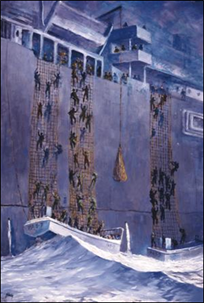
|
|
|
|
|
|
|
|
|
|
|
|
|
|
|
|
|
|
|
|
|
|
|
|
|
|
|
|
|
|
|
|
|
|
|
|
|
|
|
|
|
|
|
|
|
|
|
|
|
|
|
|
|
|
|
|
|
|
|
|
|
|
|
|
|
|
|
|
|
|
|
|
|
|
|
|
|
|
|
|
|
|
|
|
|
|
|
|
|
|
|
|
|
|
|
|
|
|
|
|
|
|
|
|
|
|
|
|
|
|
|
|
|
|
|
|
|
|
|
|
|
|
|
|
|
|
|
|
|
|
|
|
|
|
|
|
|
|
|
|
|
|
|
|
| Pre-attack
embarkation into LCVPs amid ocean swells |
|
|
|
|
|
|
|
| http://cdn06.usni.org/sites/default/files/imagecache/story-large/stories/FF39AC4327A74BCB8C7A4E7E3B947A29.jpg |
|
|
|
|
|
|
|
|
|
|
|
|
|
|
|
| Our
third wave was to embark in landing boats, as we lacked sufficient amphibious
tractors (called “amtracs”) to carry all the waves in. This would be the first time amtracs were
used in a direct assault landing. Our
boat milled around the USS Sheridan, circling until all boats joined up. Suddenly, several huge geysers erupted as
shells exploded between us and the transport.
A large dual-purpose Jap gun had again come to life from the northwest
point of the island, trying to disrupt our landing operations. Then another round came closer to our
ship. The next round surely would have
the range. The ship’s propeller came
to life, churning as it steamed out of range.
Our escort destroyers spotted the troublesome gun and immediately
opened fire. WHAM! WHAM! and the Jap gun was silent. |
|
|
|
|
|
|
|
|
|
|
|
|
|
|
|
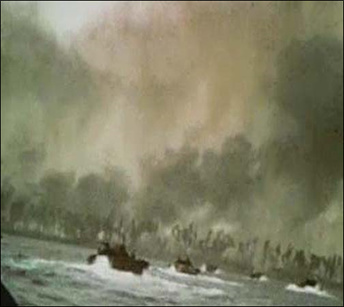
|
|
|
|
|
|
|
|
|
|
|
|
|
|
|
|
|
|
|
|
|
|
|
|
|
|
|
|
|
|
|
|
|
|
|
|
|
|
|
|
|
|
|
|
|
|
|
|
|
|
|
|
|
|
|
|
|
|
|
|
|
|
|
|
|
|
|
|
|
|
|
|
|
|
|
|
|
|
|
|
|
|
|
|
|
|
|
|
|
|
|
|
|
|
|
|
|
|
|
|
|
|
|
|
|
|
|
|
|
|
|
|
|
|
|
|
|
|
|
|
|
|
|
|
|
|
|
|
|
|
|
|
|
|
|
|
|
|
|
|
|
|
|
|
| Colorized
photograph taken just before H-Hour as amtracs approach Betio’s north
shore |
|
|
|
|
|
|
|
| http://www.ww2gyrene.org/assets/tarawa_goingin.jpg |
|
|
|
|
|
|
|
|
|
|
|
|
|
|
|
| The
morning sun was up but hardly visible:
dark billowing clouds of smoke covered the entire island. It had been less than half an hour since
our transports received return fire from the Japanese defenders. |
|
|
|
|
|
|
|
|
|
|
|
|
|
|
|
| Two
minesweepers slowly proceeded into the channel entrance to the lagoon to
clear our path of mines. Again, two
Japanese shore batteries, just beyond the extended pier, took the transports
under fire. Again, the leading
destroyer instantly engaged and silenced those positions. |
|
|
|
|
|
|
|
|
|
|
|
|
|
|
|
|
|
|
|
|
|
|
|
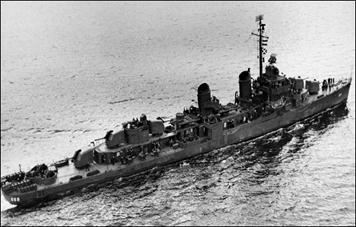
|
|
|
|
|
|
|
|
|
|
|
|
|
|
|
|
|
|
|
|
|
|
|
|
|
|
|
|
|
|
|
|
|
|
|
|
|
|
|
|
|
|
|
|
|
|
|
|
|
|
|
|
|
|
|
|
|
|
|
|
|
|
|
|
|
|
|
|
|
|
|
|
|
|
|
|
|
|
|
|
|
|
|
|
|
|
|
|
|
|
|
|
|
|
|
|
|
|
|
|
|
|
|
|
|
|
|
|
|
|
|
|
| USS Dashiell (DD-659) |
|
|
|
|
|
|
|
| http://www.navsource.org/archives/05/0565915.jpg |
|
|
|
|
|
|
|
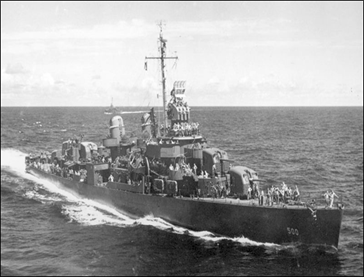
|
|
|
|
|
|
|
|
|
|
|
|
|
|
|
|
|
|
|
|
|
|
|
|
|
|
|
|
|
|
|
|
|
|
|
|
|
|
|
|
|
|
|
|
|
|
|
|
|
|
|
|
|
|
|
|
|
|
|
|
|
|
|
|
|
|
|
|
|
|
|
|
|
|
|
|
|
|
|
|
|
|
|
|
|
|
|
|
|
|
|
|
|
|
|
|
|
|
|
|
|
|
|
|
|
|
|
|
|
|
|
|
|
|
|
|
|
|
|
|
|
|
|
|
|
|
|
|
|
|
|
|
|
|
|
|
| USS Ringgold (DD-500), first destroyer into the lagoon |
|
|
|
|
|
|
|
| http://www.defensemedianetwork.com/stories/slugging-it-out-in-tarawa-lagoon/#comments |
|
|
|
|
|
|
|
|
|
|
|
|
|
|
|
| A
second destroyer (Ringgold)
entered the lagoon to assist in close fire support. It, too, was fired upon by Jap shore
batteries. Several shells splashed
close to the second destroyer. Within
minutes a shell punched into the mid-section of its starboard side, but
miraculously did not explode--no doubt a dud.
In revenge, the damaged destroyer trained its turrets on the suspected
position and opened fire. The huge
explosion signaled an obvious hit on the gun and its ammunition dump. (The
hyperlink below the Ringgold photograph is well-worth accessing: copy or type the URL into
a browser.) |
|
|
|
|
|
|
|
|
|
|
|
|
|
|
|
| Now
assault crafts headed into the channel preceded by the picket boats which
would guide us to the line of departure, a few thousand yards from the beach,
and give us additional covering fire.
Naval shelling was still conducted at this point, although the island
was no longer visible--just clouds of red dust with patches of black smoke
rising from within. |
|
|
|
|
|
|
|
|
|
|
|
|
|
|
|
| The
first two waves aligned with the picket boats and headed in; then our wave
formed up and followed. My landing
boat had been overhauled in New Zealand, with ¼” steel plates mounted on the
sides for added protection. The
additional weight made the boat draw more water, but it was still a visible
target. About two thousand yards out
we began to receive long-range automatic fire. Bullets sounding like hailstones bounced
off the plated sides while others whistled overhead. |
|
|
|
|
|
|
|
|
|
|
|
|
|
|
|
| Just
before we reached the edge of the coral reef, I looked through one of the
ramp openings to see how the first two waves on Red Beach 2 and 3 had
fared. The Japs waited until the
amtracs unloaded their men onto the beach, then opened fires with everything
they had. I watched Marines
desperately running to the sea wall at the water’s edge, while white tracer
bullets hailed on them from all angles.
I could see Marines falling while others still moved forward. It would be a miracle if any survived that
fusillade of bullets. |
|
|
|
|
|
|
|
|
|
|
|
|
|
|
|
| Saturation
bombing of Betio with more than 400,000 tons of explosives prior to and on
D-Day morning neutralized a majority of the dual-purpose anti-aircraft
positions and numerous anti-boat guns but was unsuccessful in eliminating
dug-in beach defenses that took our landing forces under violent, threatening
fire. Several amtracs found openings
in the sea wall and proceeded with their troops directly inland to the
northwest taxiways of the airstrip.
Others did not fare as well and were stopped on the beaches. |
|
|
|
|
|
|
|
|
|
|
|
|
|
|
|
| Reaching
the reef’s edge, our boat’s coxswain for some reason decided to turn the boat
around, perhaps figuring the water might not be deep enough to clear the
coral reef. A Marine lieutenant in the
boat mistook the move, pulled his .45 pistol, and ordered, “Turn this boat
around coxswain, and head back in!” As
we turned about, we came alongside a boat that had been hit just before it
reached the reef. Survivors were
swimming to the nearest boats; several were hauled into our boat, shaken up
but not seriously wounded. One Marine,
his clothes in shreds and himself in shock, swam around the stern of our boat
to avoid incoming fire, decided there were too many in the boat already,
dropped back into the water, and swam farther out to another boat. |
|
|
|
|
|
|
|
|
|
|
|
|
|
|
|
| After
picking up survivors, we continued our approach to Red Beach 3, where I saw
the first two waves of men being mowed down.
Our ships’ fire let up as our fighter planes and dive bombers worked
the island over, passing directly over our heads, firing their machine guns,
and releasing their bomb loads as they nosed in at tree-top level. How unbelievable to see that tremendous
amount of firepower our Navy was unleashing on the Japs. And yet, as we
Marines would say, “Ya, there’s always one Jap bastard that didn’t get the
word and he’s waiting for you.” In
short, we never believed that shelling alone would eliminate the enemy. There was always a job left for the
Marines--to go in and finish them off. |
|
|
|
|
|
|
|
|
|
|
|
|
|
|
|
| The
Japs did come to life with long-range machine gun fire, anti-boat guns,
mortars, and small-arms fire. The
withering firepower took its toll on other landing forces, especially those
who were dropped off at the edge of the shallow coral reef and had to wade
in. Several aerial bursts cut loose
over our boat, but were more powder than shrapnel. |
|
|
|
|
|
|
|
|
|
|
|
|
|
|
|
| Someone
again had given us the “bum dope” regarding tides around the island; there
was only three feet or less of water over the reef--not enough to carry boats
up to the beaches. Our coxswain again
headed for the reef’s edge, but the engine sputtered and stopped. He tried to start it, to no avail. To this day, I thank that young coxswain at
the helm for having enough sense to see that we weren’t going to make it over
that reef. Even under threat of a .45, he probably pulled a wire or
something. |
|
|
|
|
|
|
|
|
|
|
|
|
|
|
|
| As
the coxswain worked on the engine, the boat began to drift with the
current. Fortunately, the tide was
heading out and the boat drifted away from the island, back toward the
channel, still under a constant barrage from anti-boat guns or artillery
fire. One of the picket boats took us
under tow back to our transport, the Sheridan. After we climbed
aboard by way of the landing nets, the ship’s crew gave us orange juice and
coffee, and then we were ordered over the side again into another boat. |
|
|
|
|
|
|
|
|
|
|
|
|
|
|
|
| That
was the longest morning of my life, yet it had been only an hour since our
boat had stalled. |
|
|
|
|
|
|
|
|
|
|
|
|
|
|
|
| [In the
following photograph, a production line at Higgins Industries Incorporated,
New Orleans, Louisiana.] |
|
|
|
|
|
|
|
|
|
|
|
|
|
|
|
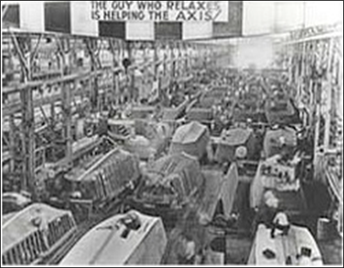
|
|
|
|
|
|
|
|
|
|
|
|
|
|
|
|
|
|
|
|
|
|
|
|
|
|
|
|
|
|
|
|
|
|
|
|
|
|
|
|
|
|
|
|
|
|
|
|
|
|
|
|
|
|
|
|
|
|
|
|
|
|
|
|
|
|
|
|
|
|
|
|
|
|
|
|
|
|
|
|
|
|
|
|
|
|
|
|
|
|
|
|
|
|
|
|
|
|
|
|
|
|
|
|
|
|
|
|
|
|
|
|
|
|
|
|
|
|
|
|
|
|
|
|
|
|
|
|
| For
more on the Higgins landing craft legend, copy these URLs into a browser. |
|
|
|
|
|
|
|
| http://www.higginsmemorial.com and
http://higginsclassicboats.org/ |
|
|
|
|
|
|
|
|
|
|
|
|
|
|
|
| By
now, someone had been convinced that boats were not making it over the reef,
and Marines walking in knee-deep water were easy prey for the Japs. Due to poor communications or because they
were ordered to, many boats still attempted to pass over the reef, only to go
aground or dump their passengers into the depths of the reef’s outer edges. |
|
|
|
|
|
|
|
|
|
|
|
|
|
|
|
| Our
second boat’s coxswain was now informed about the reef’s danger. We met an amtrac near the white coral reef
and transferred to the tracked vehicle for the short ride to the beach. Marine amtrac drivers alerted to the heavy
fire on Red Beach 3 decided to take us in along the west side of the 500-yard
wooden pier, affording some protection from the withering fire. Our landing
actually occurred on Red 2. Our amtrac
driver took us halfway down the length of the pier, keeping the amtrac close
to the pilings. “This is it,” he
yelled. “I’ve got to head back and
pick up another load.” |
|
|
|
|
|
|
|
|
|
|
|
|
|
|
|
| Sounds
of battle concentrated in such a limited area as Tarawa were deafening. The air was filled with the continuous
whistling and zinging of bullets, the close proximity of major-caliber
explosions, and the agony of hearing fellow Marines being killed all around
me. It’s strange how one’s mind works
under stress. I was alert and
determined, yet damned scared. I had a
right to be. For a second a strange
thought came to mind: Wouldn’t it be
nice to be somewhere else right now? |
|
|
|
|
|
|
|
|
|
|
|
|
|
|
|
| There
was no way to dodge anything. All I
could do was hunch down and keep moving.
Once my ears adapted to the noise, my sixth sense and training took
over and I systematically ordered my scouting team forward toward the
beach. The carnage of floating bodies,
Marines as well as Japs, plus thousands of dead fish covered the shoreline,
while other bodies floated out to sea with the tides, some becoming victims
of sharks. |
|
|
|
|
|
|
|
|
|
|
|
|
|
|
|
| There
were still Jap snipers hidden under the pier, who took pot shots as Marines
went by. Just as I passed an opening
between the pilings, I heard a “zing,” and something hot brushed the seat of
my pants. Feeling the edge of my back
pocket, I discovered that a Jap sniper bullet had skimmed my left buttock,
cutting the threads from the seam of my lower left pocket! Assuming that it may have been a stray
bullet coming through the opening, but not taking any chances, I lobbed a
couple of grenades on both sides of the gap and continued toward the beach. |
|
|
|
|
|
|
|
|
|
|
|
|
|
|
|
| A
shock brought reality home. I passed a
dead Marine lying on a pile of coral along the pier, his pack blasted open
and his personal gear strewn on the coral rocks. Photographs of his family and a young lady
floated around him. I was sorry
afterward that I had viewed the incident.
Japanese carried similar pictures, several of which I had retained … In both cases, I thought, neither family
will ever know how the end came about. |
|
|
|
|
|
|
|
|
|
|
|
|
|
|
|
| Trained
first as a pioneer company, we were in Company D, 2nd Battalion, 18th Marines. We were
deployed as basically assault infantry:
We were experts in demolitions; we operated heavy equipment such as
bulldozers, we distilled drinking water; we handled flamethrowers. The Navy decided to call us Shore
Party. As a reconnaissance NCO, I was
assigned with my team of three men to go in with the assault troops and
reconnoiter the beach in my landing sector for places to bring in our
battalion supplies. |
|
|
|
|
|
|
|
|
|
|
|
|
|
|
|
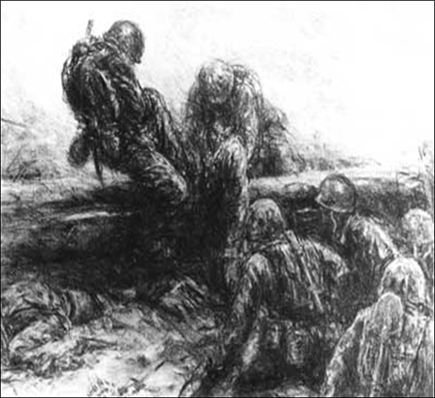
|
|
|
|
|
|
|
|
|
|
|
|
|
|
|
|
|
|
|
|
|
|
|
|
|
|
|
|
|
|
|
|
|
|
|
|
|
|
|
|
|
|
|
|
|
|
|
|
|
|
|
|
|
|
|
|
|
|
|
|
|
|
|
|
|
|
|
|
|
|
|
|
|
|
|
|
|
|
|
|
|
|
|
|
|
|
|
|
|
|
|
|
|
|
|
|
|
|
|
|
|
|
|
|
|
|
|
|
|
|
|
|
|
|
|
|
|
|
|
|
|
|
|
|
|
|
|
|
|
|
|
|
|
|
|
|
|
|
|
|
|
|
|
|
|
|
|
|
|
|
|
|
|
|
|
|
|
|
|
|
|
|
|
|
|
|
|
|
|
|
|
|
|
|
|
|
|
|
|
|
|
|
|
|
| “March
Macabre,” a sketch by combat artist Kerr Eby, reflects the familiar Betio
scene of wounded or lifeless Marines being pulled to shelter under fire by
their buddies. U.S.
Navy Combat Art Collection |
|
|
|
|
|
|
|
| http://www.nps.gov/history/history/online_books/npswapa/extcontent/usmc/pcn-190-003120-00/sec6.htm |
|
|
|
|
|
|
|
| On
Tarawa (as we called the battle, referring to Betio) there was really no rear
echelon; once you hit the beach, if you were lucky you were in the front
lines, which were measured in yards along the sea wall. Fighting was at close quarters. In a sense it was organized confusion. Assault teams had overlapped upon landing
and were pinned down behind the three-foot-high coconut-log sea wall, just
yards from Japanese gun ports and infantry trenches. |
|
|
|
|
|
|
|
|
|
|
|
|
|
|
|
| Marines
first lobbed grenades into the defenders’ positions (and received a good
number in return), killing or forcing the remainder to take cover. This attack was followed with flamethrowers
and automatic fire. At times the
enraged, trapped Japs would attack with bayonets, engaging Marines in
hand-to-hand fighting. There were
heavy losses on both sides, but the determined Marines took a yard at a time,
slowing moving inland. |
|
|
|
|
|
|
|
|
|
|
|
|
|
|
|
| As we
gained footage on the beach, I returned to the end of the pier with my recon
team to assist and direct the supplies that were arriving aboard
amtracs. |
|
|
|
|
|
|
|
|
|
|
|
|
|
|
|
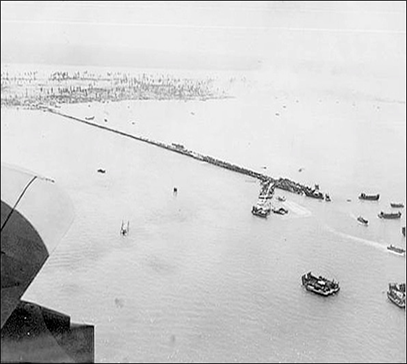
|
|
|
|
|
|
|
|
|
|
|
|
|
|
|
|
|
|
|
|
|
|
|
|
|
|
|
|
|
|
|
|
|
|
|
|
|
|
|
|
|
|
|
|
|
|
|
|
|
|
|
|
|
|
|
|
|
|
|
|
|
|
|
|
|
|
|
|
|
|
|
|
|
|
|
|
|
|
|
|
|
|
|
|
|
|
|
|
|
|
|
|
|
|
|
|
|
|
|
|
|
|
|
|
|
|
|
|
|
|
|
|
|
|
|
|
|
|
|
|
|
|
|
|
|
|
|
|
|
|
|
|
|
|
|
|
|
|
|
|
|
|
|
|
|
|
|
|
|
|
|
|
|
|
|
|
|
|
|
|
|
|
|
|
|
|
|
|
|
|
|
|
|
|
|
|
| The
1,600’ government pier on Betio’s north shore provided a deep water docking
facility |
|
|
|
|
|
|
|
| for
oceangoing vessels could to service the needs of the islanders. |
|
|
|
|
|
|
|
| http://www.tarawaontheweb.org/pierhead.jpg |
|
|
|
|
|
|
|
| http://pwencycl.kgbudge.com/T/a/Tarawa.htm |
|
|
|
|
|
|
|
|
|
|
|
|
|
|
|
| [From
west to east (right to left) in the above photograph, the smoke of the Betio
battlefield obscures the Bird’s Beak and cove of Red Beach 1. Then, Red Beach 2 up to the foot of the
pier is in view. The process of
continuing to unload needed supplies continued throughout the battle, as
shown by the large amount of supplies on the one-third of the pier closest to
the pierhead.] |
|
|
|
|
|
|
|
|
|
|
|
|
|
|
|
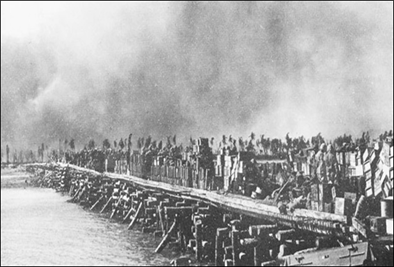
|
|
|
|
|
|
|
|
|
|
|
|
|
|
|
|
|
|
|
|
|
|
|
|
|
|
|
|
|
|
|
|
|
|
|
|
|
|
|
|
|
|
|
|
|
|
|
|
|
|
|
|
|
|
|
|
|
|
|
|
|
|
|
|
|
|
|
|
|
|
|
|
|
|
|
|
|
|
|
|
|
|
|
|
|
|
|
|
|
|
|
|
|
|
|
|
|
|
|
|
|
|
|
|
|
|
|
|
|
|
|
|
|
|
|
|
|
|
|
|
|
|
|
|
|
|
|
|
| A sea
level view of the supply problem Mike faced |
|
|
|
|
|
|
|
| http://www.ibiblio.org/hyperwar/USMC/USMC-M-Tarawa/USMC-M-Tarawa-3.html |
|
|
|
|
|
|
|
|
|
|
|
|
|
|
|
| There
was still no place to move the supplies either inland or even on the
beach. Boxes began to stack up along
the length of the pier, and we used them as barriers against the intensive
small-arms fire coming from a large blockhouse just east of the pier. As
Marines went about their work of unloading or carrying the supplies, many
became casualties from the fusillade of bullets continuously whistling across
the pier. Some Marines even bravely
walked upright, taking their chances. |
|
|
|
|
|
|
|
|
|
|
|
|
|
|
|
| The
first night, after gaining a foothold measured in yards, Marines began to dig
in along the beach and to set up defenses, expecting a counterattack that
night. My squad tried to get whatever
sleep we could by lying in any open space between stacks of boxes. Many boxes contained ammunition. |
|
|
|
|
|
|
|
|
|
|
|
|
|
|
|
| There
is never complete silence at night during combat. Firing is intermittent, generally from a
Jap sniper. Or using taunts ridiculing
Eleanor or President Roosevelt, the Japs try to get Marines to give away
their positions. |
|
|
|
|
|
|
|
|
|
|
|
|
|
|
|
| (As
we did on Guadalcanal), after first being trigger-happy, we advanced to fire
discipline--calling our shots and firing only when necessary. Japs began to infiltrate among the Marines,
seeking out weak points. Illuminating
star shells were periodically fired over Japs’ positions to keep them in
check. Orders went out: “Use your knives and bayonets; whatever you
do, don’t give your positions away.”
Marines held their ground at a cost to many, attesting to the gruesome
scenes of dead bodies still interlocked in combat. Along with fire discipline we learned to
sleep whenever possible, generally in short spans, alternating with a
buddy. We were so exhausted that we
could turn off the battle noises and take short cat-naps whenever possible. |
|
|
|
|
|
|
|
|
|
|
|
|
|
|
|
| [21
November: D+1] At
first light of the second morning on Tarawa, I gathered my gear and nudged a
Marine lying next to me. At first I
thought he was sleeping, with his head resting on his pack and his rifle
along side. As I nudged him, he rolled over. He had taken a bullet through the forehead
during the night. He had been lying on
the exposed side of the pier next to me and somehow shielded my body. |
|
|
|
|
|
|
|
|
|
|
|
|
|
|
|
| The
second morning was a repeat of the day before. Marines were still trying to wade ashore
under intensive fire from a Jap machine gun position on the west end of Red
Beach 2. Then we discovered that the
Japs had swum out to our disabled amtracs east of the pier and were firing
machine guns at us. On the west side
we were receiving enemy fire from an old interisland freighter (R.C.S. Nimanoa) scuttled on December 9,
1942 by the British and thought to have been neutralized the day before. |
|
|
|
|
|
|
|
| http://tighar.org/Publications/TTracks/15_1/mrsobrian.html |
|
|
|
|
|
|
|
|
|
|
|
|
|
|
|
| [The
context of the article in the above hyperlink has bearing on a not-unrelated
aspect of Mike Master’s report. The
1999 article avails readers of a glimpse into an event of widespread interest
to the public in the late 1930s and 1940s. During pre-battle briefings on
approach to Tarawa Atoll, Marines had been instructed to keep an eye out for
any possible evidence of Amelia Earhart, the American aviatrix who almost
completed an around-the-world flight in 1937.
In July 1937, she and her co-pilot Fred Noonan mysteriously
disappeared and their whereabouts have never been discovered. Their planned flight path took them through
the area roughly delimited by Tarawa Atoll on left and Gardner Island on
their right. They made radio contact
with the U.S. Coast Guard vessel Itasca positioned off Howland Island, and they reported low fuel
reserves. Yet, they were never heard
from again, and no reliable evidence of them has been found. That is why,
prior to the assault on Tarawa, Marines were advised to be alert to any
possibility the two aviators might have found their way to Tarawa. |
|
|
|
|
|
|
|
| http://news.discovery.com/history/us-history/amelia-earhart-resting-place.htm |
|
|
|
|
|
|
|
| http://www.biography.com/people/amelia-earhart-9283280?page=6 |
|
|
|
|
|
|
|
| Roy W.
Roush, Open Fire! (Apache
Junction, Arizona: Front Line Press,
2003), 201.] |
|
|
|
|
|
|
|
|
|
|
|
|
|
|
|
|
|
|
|
|
|
|
|
|
| |
|
|
|
|
|
|
|
|
|
|
|
|
|
|
|
|
|
|
|
|
|
|
|
|
|
|
|
|
|
|
|
|
|
|
|
|
|
|
|
|
|
|
|
|
|
|
|
|
|
|
|
|
|
|
|
|
|
|
|
|
|
|
|
|
|
|
|
|
|
|
|
|
|
|
|
|
|
|
|
|
|
|
|
|
|
|
|
|
|
|
|
|
|
|
|
| Royal Colony
Ship Nimanoa in her ‘better days’ |
|
|
|
|
|
|
|
| Photo
courtesy: E.R. Bevington; permission
to use above photos from Ric Gillespie, author of |
|
|
|
|
|
|
|
| FINDING AMELIA: The True Story
of the Earhart Disappearance (2009) |
|
|
|
|
|
|
|
| http://tighar.org/Publications/TTracks/15_1/mrsobrian.html |
|
|
|
|
|
|
|
|
|
|
|
|
|
|
|
| Fighter
planes were called in to strafe the infiltrated amtracs then they
concentrated on the old freighter, beached at the reef’s edge. Each time a bomb scored a hit, a huge,
billowing red cloud of dust and metal filled the air. The determined Japs continue to fire on
incoming Marines. A Marine unit was
finally dispatched to approach the hulk and in short order eliminated the
surprised Jap gunners. |
|
|
|
|
|
|
|
|
|
|
|
|
|
|
|
| A
Marine from our company had landed in shallow water near the scuttled
freighter, possibly wounded by the same Jap gunners. He attempted to seek cover behind the stern
of the ship. Barely standing up he
sighted a figure approaching thought to be a Marine because of his
helmet. The figure sloshed through the
shallow water, his rifle slung over his shoulder, unusual for a Marine. Before the Marine realized it was a Jap,
the enemy pulled the rifle from his shoulder without unslinging it and tried
to thrust the bayonet at the Marine.
Without a weapon and dropped when he was hit, the Marine grabbed the
oncoming bayonet with his bare hands.
With bleeding hands, he wrestled with his opponent. Then the Jap tried to swing his rifle from
his shoulder. As he did, the Marine,
still holding onto the bayonet, managed to bash its handle into the Jap’s
race, until he fell. The Marine
continued to rain blows on the Jap’s head, finally forcing his head
underwater and holding him there until there was no more resistance. A passing amtrac witnessed the duel and
picked up the battered and bleeding Marine, who would live to tell the tale. |
|
|
|
|
|
|
|
|
|
|
|
|
|
|
|
| Noon
of the second day. The shore party
with their armored-plated bulldozers sealed up troublesome bunkers and
machine gun nests along the beach, entombing many Japanese. |
|
|
|
|
|
|
|
|
|
|
|
|
|
|
|
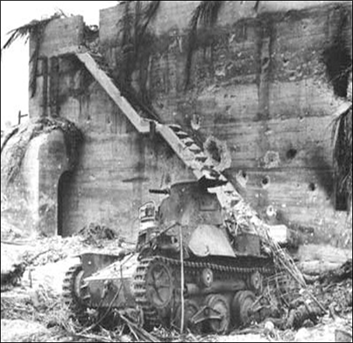
|
|
|
|
|
|
|
|
|
|
|
|
|
|
|
|
|
|
|
|
|
|
|
|
|
|
|
|
|
|
|
|
|
|
|
|
|
|
|
|
|
|
|
|
|
|
|
|
|
|
|
|
|
|
|
|
|
|
|
|
|
|
|
|
|
|
|
|
|
|
|
|
|
|
|
|
|
|
|
|
|
|
|
|
|
|
|
|
|
|
|
|
|
|
|
|
|
|
|
|
|
|
|
|
|
|
|
|
|
|
|
|
|
|
|
|
|
|
|
|
|
|
|
|
|
|
|
|
|
|
|
|
|
|
|
|
|
|
|
|
|
|
|
|
|
|
|
|
|
|
|
|
|
|
|
|
|
|
|
|
| Shibasaki’s
former Command Post, south side view, oriented northwest; November 1943 |
|
|
|
|
|
|
|
| … after our Marines were finished ! |
|
|
|
|
|
|
|
| http://www.nps.gov/history/history/online_books/npswapa/extContent/usmc/pcn-190-003120-00/sec6.htm |
|
|
|
|
|
|
|
|
|
|
|
|
|
|
|
| As work
parties came ashore to assist in handling supplies, the remainder of our
platoon was relieved and ordered to take up positions behind the big Jap
blockhouse (Rear Admiral Keiji Shibasaki’s command post) to back up troops
cleaning out the pockets of resistance with demolitions and
flamethrowers. |
|
|
|
|
|
|
|
|
|
|
|
|
|
|
|
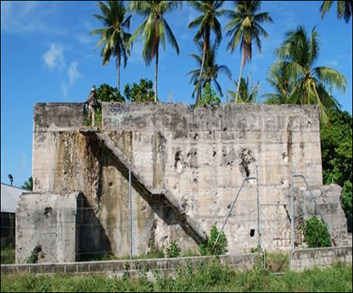
|
|
|
|
|
|
|
|
|
|
|
|
|
|
|
|
|
|
|
|
|
|
|
|
|
|
|
|
|
|
|
|
|
|
|
|
|
|
|
|
|
|
|
|
|
|
|
|
|
|
|
|
|
|
|
|
|
|
|
|
|
|
|
|
|
|
|
|
|
|
|
|
|
|
|
|
|
|
|
|
|
|
|
|
|
|
|
|
|
|
|
|
|
|
|
|
|
|
|
|
|
|
|
|
|
|
|
|
|
|
|
|
|
|
|
|
|
|
|
|
|
|
|
|
|
|
|
|
|
|
|
|
|
|
|
|
| Shibasaki’s
former Command Post, south side, oriented north; November 2008 |
|
|
|
|
|
|
|
| … 65 years after our Marines were finished! |
|
|
|
|
|
|
|
| Note
concrete doorway protectors at ground level on both corners. |
|
|
|
|
|
|
|
| Note
Dennis Covert standing at top of stairs, in passageway onto roof. |
|
|
|
|
|
|
|
| Photo
by David Brown; Dennis Covert, email to author, December 31, 2013. |
|
|
|
|
|
|
|
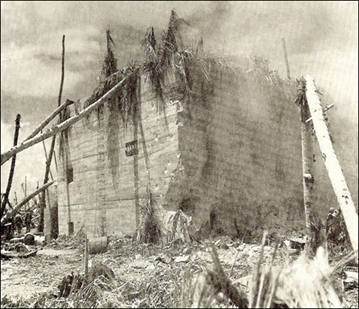
|
|
|
|
|
|
|
|
|
|
|
|
|
|
|
|
|
|
|
|
|
|
|
|
|
|
|
|
|
|
|
|
|
|
|
|
|
|
|
|
|
|
|
|
|
|
|
|
|
|
|
|
|
|
|
|
|
|
|
|
|
|
|
|
|
|
|
|
|
|
|
|
|
|
|
|
|
|
|
|
|
|
|
|
|
|
|
|
|
|
|
|
|
|
|
|
|
|
|
|
|
|
|
|
|
|
|
|
|
|
|
|
|
|
|
|
|
|
|
|
|
|
|
|
|
|
|
|
|
|
|
|
|
|
|
|
|
|
|
|
|
|
|
|
|
|
|
|
|
|
|
|
| Shibasaki’s
former Command Post, northeast corner; November 1943 |
|
|
|
|
|
|
|
| …
shortly after our Marines were finished! |
|
|
|
|
|
|
|
| Note
large concrete chunk missing on structure’s corner facing camera, |
|
|
|
|
|
|
|
| after
5” shells from our destroyers in the lagoon did this damage. |
|
|
|
|
|
|
|
| Dennis
Covert, email to author, January 1, 2014. |
|
|
|
|
|
|
|
|
|
|
|
|
|
|
|
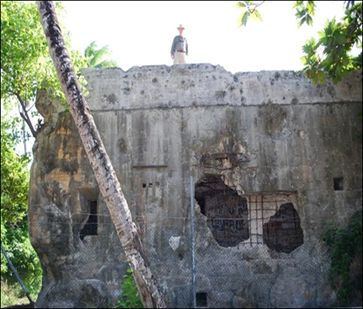
|
|
|
|
|
|
|
|
|
|
|
|
|
|
|
|
|
|
|
|
|
|
|
|
|
|
|
|
|
|
|
|
|
|
|
|
|
|
|
|
|
|
|
|
|
|
|
|
|
|
|
|
|
|
|
|
|
|
|
|
|
|
|
|
|
|
|
|
|
|
|
|
|
|
|
|
|
|
|
|
|
|
|
|
|
|
|
|
|
|
|
|
|
|
|
|
|
|
|
|
|
|
|
|
|
|
|
|
|
|
|
|
|
|
|
|
|
|
|
|
|
|
|
|
|
|
|
|
|
|
|
|
|
|
|
|
|
|
|
|
|
|
|
|
| Shibasaki’s
former Command Post, north side, November 2008 |
|
|
|
|
|
|
|
| Note
large concrete chunk missing on lower left corner; same corner as in previous
photograph, |
|
|
|
|
|
|
|
| after
5” shells from our destroyers in the lagoon did this damage. Dennis Covert on roof. |
|
|
|
|
|
|
|
| Photo
by David Brown; Dennis Covert, email to author, December 31. 2013. |
|
|
|
|
|
|
|
|
|
|
|
|
|
|
|
| [The
photographs above and below reveal the location to which Mike relocated the
remainder of his platoon on D+1.] |
|
|
|
|
|
|
|
|
|
|
|
|
|
|
|
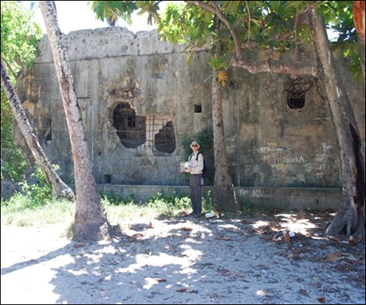
|
|
|
|
|
|
|
|
|
|
|
|
|
|
|
|
|
|
|
|
|
|
|
|
|
|
|
|
|
|
|
|
|
|
|
|
|
|
|
|
|
|
|
|
|
|
|
|
|
|
|
|
|
|
|
|
|
|
|
|
|
|
|
|
|
|
|
|
|
|
|
|
|
|
|
|
|
|
|
|
|
|
|
|
|
|
|
|
|
|
|
|
|
|
|
|
|
|
|
|
|
|
|
|
|
|
|
|
|
|
|
|
|
|
|
|
|
|
|
|
|
|
|
|
|
|
|
|
|
|
|
|
|
|
|
|
|
|
|
|
|
|
|
|
| Shibasaki’s
former Command Post (full view, north side), November 2008 |
|
|
|
|
|
|
|
| David
Brown standing in center |
|
|
|
|
|
|
|
| Photo
by Dennis Covert; Dennis Covert, email to author, December 31, 2013. |
|
|
|
|
|
|
|
|
|
|
|
|
|
|
|
| To a
degree of accuracy of less than 15 feet, GPS readings of Shibisaki’s Command
Post and Bonnyman’s Bunker are shown as follows: |
|
|
|
|
|
|
|
|
|
|
|
|
|
|
|
| SHIBISAKI'S
COMMAND POST
(sw corner) N
01° 21.453' E 172°
56.051'
21 November 2008 @ 15:11:31
local time |
|
|
|
|
|
|
|
|
|
|
|
|
|
|
|
| BONNYMAN'S
BUNKER (nw corner) N 01° 21.502'
E 172° 55.963' 19 November
2008 @ 15:13:28 local time |
|
|
|
|
|
|
|
| |
|
|
|
|
|
|
|
| From
the original report containing GPS calculations by David Brown |
|
|
|
|
|
|
|
| Dennis
Covert, email to author, December 31, 2013. |
|
|
|
|
|
|
|
|
|
|
|
|
|
|
|
| In
terms of precisely identifying the locations of Shibisaki’s Command Post and
Bonnyman’s Bunker, this writer very much appreciates the careful attention to
detail and generosity by Dennis Covert (amateur WWII historian) and his
son-in-law David Brown (professional engineer and land surveyor). Permission to incorporate certain
photographs and GPS data is also very much appreciated. |
|
|
|
|
|
|
|
|
|
|
|
|
|
|
|
| [Mike
Masters continues …] By the end of the day, more than two-thirds of the
island had been secured. Our man
"Hollywood," who liked to live it up, was a noted hot-rodder. He tinkered with a Jap light tank until he
got it started, then drove it up and down the airstrip next to our positions. A stupid thing to do--he was immediately ordered to stop. |
|
|
|
|
|
|
|
|
|
|
|
|
|
|
|
| That
evening, our platoon moved into a huge shell-hole made by a battleship salvo
and dug foxholes for the night. We
were still in doubt as to what the Japanese fleet had in mind for us. We knew it was just a matter of time until
they retaliated to support their remaining forces. Our intuition was correct. Around midnight the entire western sky was
covered with white streaks crisscrossing the horizon. Enemy planes had been spotted, skimming the
water and heading for Betio. A lone
“Betty” Mitsubishi bomber got through the flak and passed over the landing
area, dropping a string of bombs.
There was a series of explosions, the last close to our position. As the intruder roared overhead, I could
see the “red meatballs” on the wings in the light of his exhausts. Several fatalities were reported on that
beach in the morning. |
|
|
|
|
|
|
|
|
|
|
|
|
|
|
|
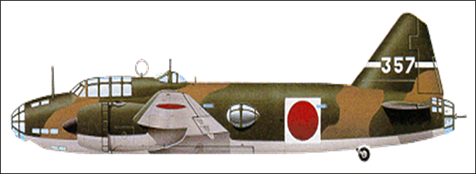
|
|
|
|
|
|
|
|
|
|
|
|
|
|
|
|
|
|
|
|
|
|
|
|
|
|
|
|
|
|
|
|
|
|
|
|
|
|
|
|
|
|
|
|
|
|
|
|
|
|
|
|
|
|
|
|
|
|
|
|
|
|
|
|
|
|
|
|
|
|
|
|
|
|
|
|
|
|
|
|
| Mitsubishi
G4M1 “Betty” bomber |
|
|
|
|
|
|
|
| 3,700
mile range; speed 265 mph (max), 196 mph (cruise) |
|
|
|
|
|
|
|
| Admiral
Yamamoto and his staff were travelling in a G4M1 |
|
|
|
|
|
|
|
| when
shot down by P-38s over Bougainville on 18 April 1943. |
|
|
|
|
|
|
|
| http://www.aviastar.org/air/japan/mitsubishi_g4m.php |
|
|
|
|
|
|
|
|
|
|
|
|
|
|
|
| [22
November, D+3] By
the third day, most of the island had been taken, except for small areas of
resistance. We began to relax a little. During the lull another Marine and I
decided to reconnoiter the eastern tail of the island on our own, making a
pact to cover each other as we moved about. We reached a small, bombed-out
building with suitcases and personal articles strewn about. It must have been a storeroom: the area was covered with offices’
uniforms, including gold-braided caps and epaulets. We hit a bonanza! Without any thought of covering each other,
we both put down our weapons--a dumb thing to do--and started to explore and
to fill our pockets. |
|
|
|
|
|
|
|
|
|
|
|
|
|
|
|
| Immediately,
we heard someone behind us yelling in Japanese. I spun around and was shocked to see a Jap
pop out of a dugout and run toward us.
He was jabbering in Japanese, frantically waving his hands as he
ran. It sounded as if he was trying to
say “Puul Haba” (Pearl Harbor), either in contempt or because he kne we used
it many times as our password. |
|
|
|
|
|
|
|
|
|
|
|
|
|
|
|
| We
had incidents with the Bushido Code on Guadalcanal, where Japanese blew
themselves up rather than surrender or be captured, usually taking a few
Marines with them. With quick
reflexes, I grabbed my carbine and fired from the hip, still in a kneeling
position. Simultaneously, I heard
another shot from the edge of a palm grove.
The Jap dropped to the ground, dead.
More about the “Bushido Code:
The Eight Virtues of the Samurai,” can be found at the following
hyperlink: |
|
|
|
|
|
|
|
| http://artofmanliness.com/2008/09/14/the-bushido-code-the-eight-virtues-of-the-samurai |
|
|
|
|
|
|
|
|
|
|
|
|
|
|
|
| A
company of Marines on a mop-up patrol emerged from the tree line. Just as the Jap had popped up, the leading
Marine had opened fire, too. The
officer in charge barked, “What the hell are you Marines doing in this
area? Don’t you know it hasn’t been
secured yet?” We had wandered past the
front lines into the Jap sector, which still had many stragglers and
snipers. “Get your asses out of here
and back to your area!” he bellowed.
We did manage to fill our pockets with many items that proved valuable
back in Hawaii. |
|
|
|
|
|
|
|
|
|
|
|
|
|
|
|
| When
we started out for the eastern point, we witnessed a gruesome sight; a
Japanese had hung himself from a post, the skin on his face dried taut from
the hot tropical sun. Two rows of gold
teeth in his gaping mouth glistened in the sun. When we returned through the same area, I
noticed that his mouth was empty--a hideous practice acquired by some Marines
either through hate or greed. |
|
|
|
|
|
|
|
|
|
|
|
|
|
|
|
| [WARNING: Discretion is advised when viewing the
following graphic image.] |
|
|
|
|
|
|
|
|
|
|
|
|
|
|
|
| We
had heard that when a Japanese knew it was inevitable he would be killed or
captured, he would kill himself by placing a grenade against his chest or by
putting a rifle barrel under his chin or in his mouth, using his big toe to
pull the trigger. This was the somber
scene we found in several bunkers. We
knew the warrior’s (Bushido) code, reinforced by superior officers, stated
that to be captured was disgraceful, and that capture meant the soldier would
never be allowed into warriors’ heaven. |
|
|
|
|
|
|
|
|
|
|
|
|
|
|
|
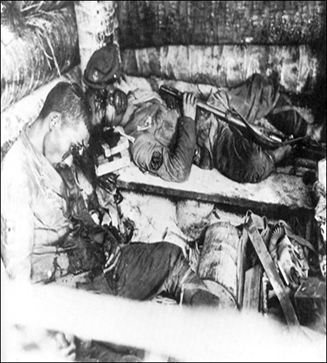
|
|
|
|
|
|
|
|
|
|
|
|
|
|
|
|
|
|
|
|
|
|
|
|
|
|
|
|
|
|
|
|
|
|
|
|
|
|
|
|
|
|
|
|
|
|
|
|
|
|
|
|
|
|
|
|
|
|
|
|
|
|
|
|
|
|
|
|
|
|
|
|
|
|
|
|
|
|
|
|
|
|
|
|
|
|
|
|
|
|
|
|
|
|
|
|
|
|
|
|
|
|
|
|
|
|
|
|
|
|
|
|
|
|
|
|
|
|
|
|
|
|
|
|
|
|
|
|
|
|
|
|
|
|
|
|
|
|
|
|
|
|
|
|
|
|
|
|
|
|
|
|
|
|
|
|
|
|
|
|
|
|
|
|
|
|
|
|
| Two
Japanese Imperial Marines chose death over surrender |
|
|
|
|
|
|
|
| USMC
photo |
|
|
|
|
|
|
|
|
|
|
|
|
|
|
|
| Our
artillery and naval gunfire caught many Japs on the eastern tip of the
island. Hundreds of their bloated
bodies were in the open trenches or in the long tank traps, possibly caught
in the open while preparing for a bonsai night attack or while just moving
about. For days those fast-decaying
bodies in the tropical sun covered the island with an unbearable stench. It was said that sailors could even smell
it offshore. |
|
|
|
|
|
|
|
|
|
|
|
|
|
|
|
|
|
|
|
|
|
|
|
| [22
November, D+3]
The last major resistance on Betio was still the big command post
blockhouse just east of the pier ["Rear Admiral Keiji Shibasaki’s command post,"
writes Mike Masters], an irritation from the very first day. The Japs were still pouring out a lot of
lead from gun ports and sandbagged positions, regardless of all the bombing
those positions took. |
|
|
|
|
|
|
|
|
|
|
|
|
|
|
|
| [In the
following photograph, the reader sees the "sloped, sanded sides" of
bunker Mike refers to. This structure
is what many refer to as "Bonnyman's Bunker," so named to honor the
valiant and self-sacrificing assault led by 1st Lt. Alexander Bonnyman to
capture this bunker on D+3.] |
|
|
|
|
|
|
|
|
|
|
|
|
|
|
|
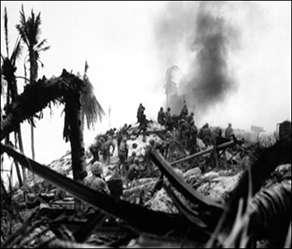
|
|
|
|
|
|
|
|
|
|
|
|
|
|
|
|
|
|
|
|
|
|
|
|
|
|
|
|
|
|
|
|
|
|
|
|
|
|
|
|
|
|
|
|
|
|
|
|
|
|
|
|
|
|
|
|
|
|
|
|
|
|
|
|
|
|
|
|
|
|
|
|
|
|
|
|
|
|
|
|
|
|
|
|
|
|
|
|
|
|
|
|
|
|
|
|
|
|
|
|
|
|
|
|
|
|
|
|
|
|
|
|
|
|
|
|
|
|
|
|
| The
“sloped, sanded sides” of the reinforced bunker Mike refers to are seen in
the above photograph. |
|
|
|
|
|
|
|
| This
structure is what many refer to as “Bonnyman’s Bunker,” so named to honor the
valiant and self- |
|
|
|
|
|
|
|
| sacrificing
assault led by 1st Lt. Alexander Bonnyman
to capture this bunker on D+3. (USMC photo) |
|
|
|
|
|
|
|
| http://www.tarawaontheweb.org/bonnyman.htm |
|
|
|
|
|
|
|
| http://claybonnymanevans.com/?page_id=5 |
|
|
|
|
|
|
|
|
|
|
|
|
|
|
|
| Several
of our flamethrowers and demolition men joined in a final charge up the
sloped, sanded sides, under cover of small-arms fire. The Japs were fanatics to the end. Several ran out from covered spider holes
on the roof of the bunker, firing and charging the Marines with fixed
bayonets. At times they fought
hand-to-hand … a deadly game of “King of the Hill.” |
|
|
|
|
|
|
|
|
|
|
|
|
|
|
|
| [Mike
Master’s reference to “a final charge up the sloped, sanded sides” causes
some ambiguity. His reference to “sloped, sanded sides” in conjunction with
the Japanese Command Post is a clue he is probably referring to the final
major resistance on Betio that he witnessed: the large sand-covered reinforced concrete structure about
425 feet to the southeast of Shibasaki’s Command Post which was not sand-covered and had no sand slopes on its sides (as seen in the following photograph).] |
|
|
|
|
|
|
|
|
|
|
|
|
|
|
|
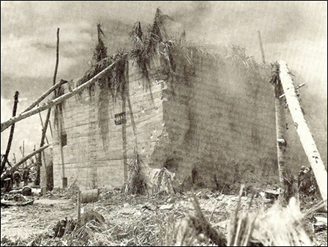
|
|
|
|
|
|
|
|
|
|
|
|
|
|
|
|
|
|
|
|
|
|
|
|
|
|
|
|
|
|
|
|
|
|
|
|
|
|
|
|
|
|
|
|
|
|
|
|
|
|
|
|
|
|
|
|
|
|
|
|
|
|
|
|
|
|
|
|
|
|
|
|
|
|
|
|
|
|
|
|
|
|
|
|
|
|
|
|
|
|
|
|
|
|
|
|
| Shibasaki’s
former Command Post, northeast corner; November 1943 |
|
|
|
|
|
|
|
| NOTE: no “sloped, sanded” exterior walls and no
sand covering the roof. |
|
|
|
|
|
|
|
| Dennis
Covert, email to author, January 1, 2014 |
|
|
|
|
|
|
|
|
|
|
|
|
|
|
|
|
|
|
|
|
|
|
|
| There
were losses on both sides, but the Japs were no match for the Marines who
bore in and methodically eliminated them. Gasoline was poured down air vents,
followed by grenades. [Construction features found on Bonnyman’s Bunker but
not on Shibasaki’s Command Post.]. The muffled explosions and screams could
be heard coming out of the openings.
The remaining Japs, who didn’t even have time to consider the Bushido
Code, came streaming out side entrances and down open trenches. Every Marine within range opened fire on
hundreds of fleeing Japs. It was like
a turkey shoot; there was really no place for them to run; the withering
Marine cross-fire eliminated every man and the last major resistance. |
|
|
|
|
|
|
|
|
|
|
|
|
|
|
|
|
|
|
|
|
|
|
|
| The
same blockhouse had received continuous fire for the past three days, with
little or no effect. I had watched a
destroyer fire point-blank with their 5” turrets, only to knock out big chips
of concrete from its sides [Details seen on Shibasaki’s Command Post but not
on Bonnyman’s Bunker.]. The Japanese
engineers had time to build a strong shelter against our gunfire, but it was
still no match against the invincible Marines. When I viewed the bunker up close, I
realized why these Japs were able to hold out longer than others. There were machine gun ports at strategic
positions, baffles air vents on the roof (which did not stop the gasoline
from going down), and protected rear entryways from where the Japs eventually
came running. |
|
|
|
|
|
|
|
|
|
|
|
|
|
|
|
|
|
|
|
|
|
|
|
| A few
yards away was a disabled light Jap tank, no doubt guarding the rear of the
bunker. Strewn about the tank were
boxes of ammunition and dozens of bloated Japanese bodies. It was obvious that some had their uniforms
burned off by our flamethrowers or the tank's gasoline. Most of the burnt nude bodies still had
leggings on, some even their trousers.
In their decomposing state they all looked chubby. Strangely, most of them were face
down. (The Japanese Field Manual
stated: "If you are slain in
battle, you should be resolved to have your corpse facing the
enemy.") The few facing up had
expressions of horror molded into their faces. Even death had its fascination, especially
when you viewed the deceased enemy who had attempted to defend himself. |
|
|
|
|
|
|
|
|
|
|
|
|
|
|
|
| The
airfield had to be made operational as soon as possible to release aircraft
carriers from staying in the area.
Bombardment was intentionally diverted from the airstrip. Even as
Marines were still mopping up on the eastern tail of the island, naval CBs
were ashore and already grading the few shell holes in the
coral-and-cement-covered runway. On
November 23 (the last day of fighting on Betio), a lone Navy Hellcat fighter
pilot made a low pass over the island; on the second approach he came in for
a landing. |
|
|
|
|
|
|
|
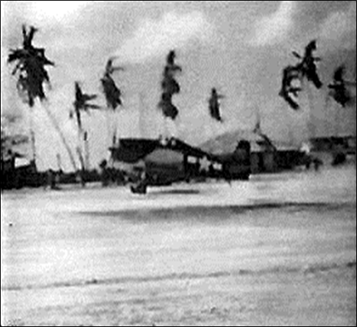
|
|
|
|
|
|
|
|
|
|
|
|
|
|
|
|
|
|
|
|
|
|
|
|
|
|
|
|
|
|
|
|
|
|
|
|
|
|
|
|
|
|
|
|
|
|
|
|
|
|
|
|
|
|
|
|
|
|
|
|
|
|
|
|
|
|
|
|
|
|
|
|
|
|
|
|
|
|
|
|
|
|
|
|
|
|
|
|
|
|
|
|
|
|
|
|
|
|
|
|
|
|
|
|
|
|
|
|
|
|
|
|
|
|
|
|
|
|
|
|
|
|
|
|
|
|
|
|
|
|
|
|
|
|
|
|
|
|
|
|
|
|
|
|
|
|
|
|
|
|
|
|
| A U.S. Navy F6F from the USS Bunker Hill (CV-17) |
|
|
|
|
|
|
|
| lands at Hawkins Field, Betio, on 23
November 1943 |
|
|
|
|
|
|
|
| http://www.tarawaontheweb.org/firstplane.htm |
|
|
|
|
|
|
|
|
|
|
|
|
|
|
|
| "Kelly
landed on Hawkins Field around noon on the last day of fighting, 23 November
after buzzing the island and circling once. Kelly was forced to fishtail his
aircraft around the Seabee's bulldozers as they were already at work
repairing and improving the airfield. After coming to a halt he climbed down
and shook hands with the grinning Marines who had come running toward his
plane. "Is it over?" was his question. "Pretty nearly,"
was the reply. Reportedly Kelly made no mention of the
stink that enveloped the island to the Marines but did report seeing a great
many dead men floating several miles out to sea." |
|
|
|
|
|
|
|
|
|
|
|
|
|
|
|
| Marines
converged on his plane to shake his hand and welcome him. |
|
|
|
|
|
|
|
|
|
|
|
|
|
|
|
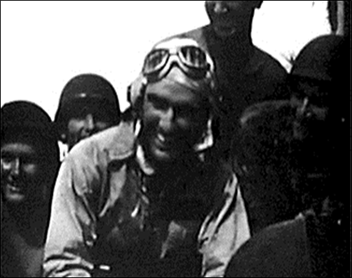
|
|
|
|
|
|
|
|
|
|
|
|
|
|
|
|
|
|
|
|
|
|
|
|
|
|
|
|
|
|
|
|
|
|
|
|
|
|
|
|
|
|
|
|
|
|
|
|
|
|
|
|
|
|
|
|
|
|
|
|
|
|
|
|
|
|
|
|
|
|
|
|
|
|
|
|
|
|
|
|
|
|
|
|
|
|
|
|
|
|
|
|
|
|
|
|
|
|
|
|
|
|
|
|
|
|
|
|
|
|
|
|
|
|
|
|
|
|
|
|
|
|
|
|
|
|
|
|
|
|
|
|
|
|
|
|
| Ensign
William W. Kelly, the fighter pilot Mr. Masters refers to |
|
|
|
|
|
|
|
| http://www.tarawaontheweb.org/firstplane.htm |
|
|
|
|
|
|
|
|
|
|
|
|
|
|
|
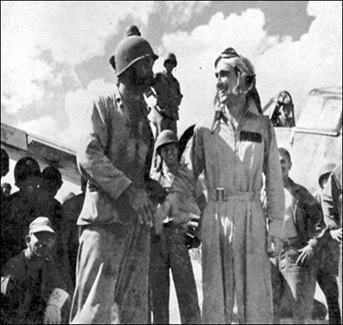
|
|
|
|
|
|
|
|
|
|
|
|
|
|
|
|
|
|
|
|
|
|
|
|
|
|
|
|
|
|
|
|
|
|
|
|
|
|
|
|
|
|
|
|
|
|
|
|
|
|
|
|
|
|
|
|
|
|
|
|
|
|
|
|
|
|
|
|
|
|
|
|
|
|
|
|
|
|
|
|
|
|
|
|
|
|
|
|
|
|
|
|
|
|
|
|
|
|
|
|
|
|
|
|
|
|
|
|
|
|
|
|
|
|
|
|
|
|
|
|
|
|
|
|
|
|
|
|
|
|
|
|
|
|
|
|
|
|
|
|
|
|
|
|
|
|
|
|
|
|
|
|
| Ensign
William W. Kelly |
|
|
|
|
|
|
|
| http://www.tarawaontheweb.org/firstpilot2.jpg |
|
|
|
|
|
|
|
|
|
|
|
|
|
|
|
| [In
November and December 2012, this writer contacted Ensign Kelly’s son, William
W. Kelly II, who is a respected, 33-year tenured anthropology professor at
Yale University. The son reports,
“William Kelly was my father, and my three brothers and I are aware and proud
of his Tarawa landing and his Navy service.
He actually stayed in the Navy after the war and remained a carrier
pilot in the Korean War and afterwards.
He retired in the late 1960s as a captain and began a second career as
a lawyer in Utica, NY (having graduated from Georgetown Law School while in
the Navy in the 1950s). He passed away
at home in 2001. Being here in New
Haven, it is enjoyable to be close to New York City, where the aircraft
carrier USS Intrepid is
permanently based and open to the public.
I remember when my father served as Air Officer on the carrier, and we
can now climb to the control tower and main Air Officer cabin as we once did
when he was stationed onboard in the Mediterranean.”] William W. Kelly II, emails to author, November 30, 1012 and
December 6, 2012. |
|
|
|
|
|
|
|
|
|
|
|
|
|
|
|
| Marines
cleaned out the last pockets of resistance with coordinated attacks. The stubborn Japs were methodically
eliminated. Those who still persisted
were covered and entombed by bulldozers.
No matter how thorough we were, a few snipers held out, taking
pot-shots at anyone. |
|
|
|
|
|
|
|
|
|
|
|
|
|
|
|
| The
island was quiet, and everyone began to relax a little. It was time to clean up and see that our
weapons were ready for any counterattack.
A group of us were washing under a Jap water tower that was filled
with holes but somehow still holding water, when there was a sharp crack of a
Jap rifle above us and a Marine next to me fell to the ground with a bullet
between his eyes. We grabbed our
weapons and methodically sprayed the tops of palm trees until a dead Jap fell
from one, just fifty feet away. This
sniping went on for days, even after our division left. |
|
|
|
|
|
|
|
|
|
|
|
|
|
|
|
| After
going through seventy-two hours of hell, it was unbelievable that the battle
was over. The sounds of battle were
gone; the quiet was deafening. The island looked like one big, dusty garbage
dump, strewn with mangled junk, shattered palm trees, and dead bodies
everywhere. Those of us who had
survived were dirty, tired, and hadn’t eaten a good meal since we left the
transports. Even with death about us
we attempted to eat what field rations we had, although many of us hadn’t
even touched those since we landed three days earlier. During the excitement of battle, there
wasn’t even time for a bowel movement. |
|
|
|
|
|
|
|
|
|
|
|
|
|
|
|
| Mopping-up
operations continued on the eastern tip of the island. The thousands of decaying bodies had to be
buried immediately to prevent contamination.
Japanese bodies were laid in long, bulldozed graves. At first, Marines
were buried individually until we realized that they, too had to be buried as
quickly as possible. Long trenches
were bulldozed and the Marines were laid side-by-side, wrapped in ponchos and
blankets and covered over by the bulldozers. |
|
|
|
|
|
|
|
|
|
|
|
|
|
|
|
| The
first group of Marines were buried where they were found, the sites marked
with crude crosses with their names inscribed. The majority of Marines were found on the
beaches where they had come in under withering fire those first three days. |
|
|
|
|
|
|
|
|
|
|
|
|
|
|
|
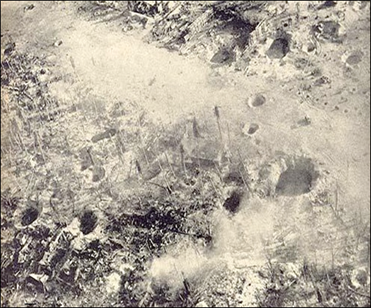
|
|
|
|
|
|
|
|
|
|
|
|
|
|
|
|
|
|
|
|
|
|
|
|
|
|
|
|
|
|
|
|
|
|
|
|
|
|
|
|
|
|
|
|
|
|
|
|
|
|
|
|
|
|
|
|
|
|
|
|
|
|
|
|
|
|
|
|
|
|
|
|
|
|
|
|
|
|
|
|
|
|
|
|
|
|
|
|
|
|
|
|
|
|
|
|
|
|
|
|
|
|
|
|
|
|
|
|
|
|
|
|
|
|
|
|
|
|
|
|
|
|
|
|
|
|
|
|
|
|
|
|
|
|
|
|
|
|
|
|
|
|
|
|
| Withering
fire changes landscapes into moonscapes, as on Betio |
|
|
|
|
|
|
|
| http://saltofamerica.com/contents/displayArticle.aspx?18_176 |
|
|
|
|
|
|
|
|
|
|
|
|
|
|
|
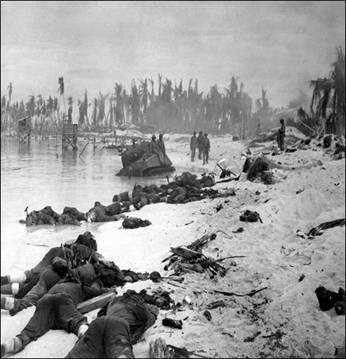
|
|
|
|
|
|
|
|
|
|
|
|
|
|
|
|
|
|
|
|
|
|
|
|
|
|
|
|
|
|
|
|
|
|
|
|
|
|
|
|
|
|
|
|
|
|
|
|
|
|
|
|
|
|
|
|
|
|
|
|
|
|
|
|
|
|
|
|
|
|
|
|
|
|
|
|
|
|
|
|
|
|
|
|
|
|
|
|
|
|
|
|
|
|
|
|
|
|
|
|
|
|
|
|
|
|
|
|
|
|
|
|
|
|
|
|
|
|
|
|
|
|
|
|
|
|
|
|
|
|
|
|
|
|
|
|
|
|
|
|
|
|
|
|
|
|
|
|
|
|
|
|
|
|
|
|
|
|
|
|
|
|
|
|
|
|
|
|
| Beach
scenes encountered by Masters and men in his company |
|
|
|
|
|
|
|
| https://upload.wikimedia.org/wikipedia/commons/1/10/Tarawa_beach_HD-SN-99-03001.JPEG |
|
|
|
|
|
|
|
|
|
|
|
|
|
|
|
| Men
from our company began scouting the beaches and found about fifteen from the
first platoon, just yards from the beach where their amphibious tractor had
lodged on a barbed wired barricade while attempt to reach the beach. Some of these men, recruits with less than
a year in the Marine Corps, had just joined the company in New Zealand. |
|
|
|
|
|
|
|
|
|
|
|
|
|
|
|
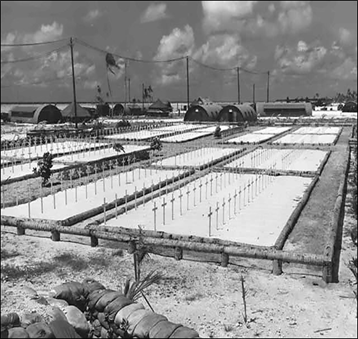
|
|
|
|
|
|
|
|
|
|
|
|
|
|
|
|
|
|
|
|
|
|
|
|
|
|
|
|
|
|
|
|
|
|
|
|
|
|
|
|
|
|
|
|
|
|
|
|
|
|
|
|
|
|
|
|
|
|
|
|
|
|
|
|
|
|
|
|
|
|
|
|
|
|
|
|
|
|
|
|
|
|
|
|
|
|
|
|
|
|
|
|
|
|
|
|
|
|
|
|
|
|
|
|
|
|
|
|
|
|
|
|
|
|
|
|
|
|
|
|
|
|
|
|
|
|
|
|
|
|
|
|
|
|
|
|
|
|
|
|
|
|
|
|
|
|
|
|
|
|
|
|
|
|
|
|
|
|
|
|
| The
largest of 37 American cemeteries at Tarawa, November 1943 |
|
|
|
|
|
|
|
| http://ww2db.com/image.php?image_id=5086 |
|
|
|
|
|
|
|
|
|
|
|
|
|
|
|
| EPITAPH
AT THE GATE OF THE SECOND MARINE DIVISION CEMETERY |
|
|
|
|
|
|
|
| ON
BETIO ISLAND |
|
|
|
|
|
|
|
| by
Captain Donald Jackson, USMC |
|
|
|
|
|
|
|
|
|
|
|
|
|
|
|
| To
you, who lie within this coral sand, |
|
|
|
|
|
|
|
| We,
who remain, pay tribute of a pledge, |
|
|
|
|
|
|
|
| That
dying, thou shalt surely not have died in vain. |
|
|
|
|
|
|
|
| That
when again bright morning dyes the sky |
|
|
|
|
|
|
|
| And
waving fronds above shall touch the rain, |
|
|
|
|
|
|
|
| We
give you this—that in those times |
|
|
|
|
|
|
|
| We
will remember. We lived and fought
together, thou and we, |
|
|
|
|
|
|
|
| And
sought to keep the flickering torch aglow |
|
|
|
|
|
|
|
| That
all our loved ones might forever know |
|
|
|
|
|
|
|
| The
blessed warmth exceeding flame, |
|
|
|
|
|
|
|
| The
everlasting scourge of bondsman's chains, |
|
|
|
|
|
|
|
| Liberty
and light. When we with loving hands
laid back the earth |
|
|
|
|
|
|
|
| That
was for moments short to couch thy form, |
|
|
|
|
|
|
|
| We did
not bid a last and sad farewell |
|
|
|
|
|
|
|
| But
only, "Rest ye well." |
|
|
|
|
|
|
|
| Then
with this humble, heartfelt epitaph |
|
|
|
|
|
|
|
| That
pays thy many virtues and acclaim |
|
|
|
|
|
|
|
| We
marked this spot, and murm'ring requiem, |
|
|
|
|
|
|
|
| Moved
on to westward. |
|
|
|
|
|
|
|
| http://www.ww2gyrene.org/2ndmardiv_history_part_4C.htm |
|
|
|
|
|
|
|
|
|
|
|
|
|
|
|
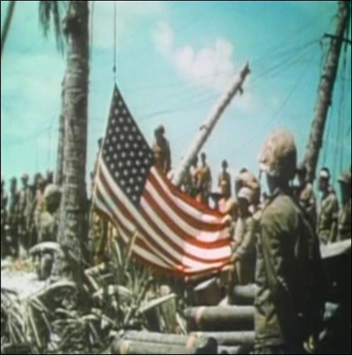
|
|
|
|
|
|
|
|
|
|
|
|
|
|
|
|
|
|
|
|
|
|
|
|
|
|
|
|
|
|
|
|
|
|
|
|
|
|
|
|
|
|
|
|
|
|
|
|
|
|
|
|
|
|
|
|
|
|
|
|
|
|
|
|
|
|
|
|
|
|
|
|
|
|
|
|
|
|
|
|
|
|
|
|
|
|
|
|
|
|
|
|
|
|
|
|
|
|
|
|
|
|
|
|
|
|
|
|
|
|
|
|
|
|
|
|
|
|
|
|
|
|
|
|
|
|
|
|
|
|
|
|
|
|
|
|
|
|
|
|
|
|
|
|
|
|
|
|
|
|
|
|
|
|
|
|
|
|
|
|
|
|
|
|
|
|
|
|
| Tarawa
post-battle: “Old Glory” just prior to
being raised |
|
|
|
|
|
|
|
| http://www.ww2gyrene.org/2ndmardiv_history_part_4C.htm |
|
|
|
|
|
|
|
|
|
|
|
|
|
|
|
| It
was still a moving and arousing moment to hear a bugler sound “Attention!”
followed by “Colors!” Every Marine
within earshot faced the direction of the flag, came to attention, and
saluted as the flag was raised. This
was the symbol of a proud, free nation, of men serving their country, of many
giving their lives, and of the rejoicing in avenging the Japanese atrocities. |
|
|
|
|
|
|
|
|
|
|
|
|
|
|
|
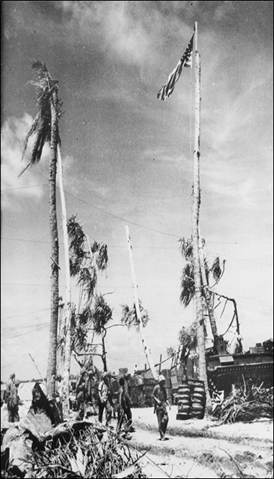
|
|
|
|
|
|
|
|
|
|
|
|
|
|
|
|
|
|
|
|
|
|
|
|
|
|
|
|
|
|
|
|
|
|
|
|
|
|
|
|
|
|
|
|
|
|
|
|
|
|
|
|
|
|
|
|
|
|
|
|
|
|
|
|
|
|
|
|
|
|
|
|
|
|
|
|
|
|
|
|
|
|
|
|
|
|
|
|
|
|
|
|
|
|
|
|
|
|
|
|
|
|
|
|
|
|
|
|
|
|
|
|
|
|
|
|
|
|
|
|
|
|
|
|
|
|
|
|
|
|
|
|
|
|
|
|
|
|
|
|
|
|
|
|
|
|
|
|
|
|
|
|
|
|
|
|
|
|
|
|
|
|
|
|
|
|
|
|
|
|
|
|
|
|
|
|
|
|
|
|
|
|
|
|
|
|
|
|
|
|
|
|
|
|
|
|
|
|
|
|
|
|
|
|
|
|
|
|
|
|
|
|
|
|
|
|
|
|
|
|
|
|
|
|
| November
22, 1943 (D+2) Betio declared secure, despite continuing worrisome skirmishes |
|
|
|
|
|
|
|
| http://www.ibiblio.org/hyperwar/USMC/USMC-M-Tarawa/img/USMC-M-Tarawa-p61.jpg |
|
|
|
|
|
|
|
|
|
|
|
|
|
|
|
| One
scene the public back in the States never saw in newsreels, newspapers, or
even in books was the dual flag-raising ceremony I had witness on Tulagi,
Solomon Islands, and now on Betio, Tarawa.
In each case, as an allied gesture because these islands had been
British protectorates, the Union Jack was raised atop an adjacent palm tree
the same time the American flag went up. At the time I
resented it and heard a lot of other Marines grumbling about it. After tall the trouble of taking back the
island, we felt that at least the brass could have had another ceremony to
raise the Union Jack. (I have since noted in many historical military books,
that in these flag-raising scenes the “other” flag was always cropped out and
no mention was made of it. Guess that
was politics, which we were not supposed to understand.) |
|
|
|
|
|
|
|
|
|
|
|
|
|
|
|
| Before
leaving, I toured the island to take a closer look at the total destruction
of everything above ground. Still
cautious about entering dugouts and gun emplacements, I dropped in a few
grenades after calling to make sure there were no Marines inside. It was fascinating to see the number of
huge dual-purpose guns and the many medium-to-small gun emplacements that
took a toll of our comrades in those three days. |
|
|
|
|
|
|
|
|
|
|
|
|
|
|
|
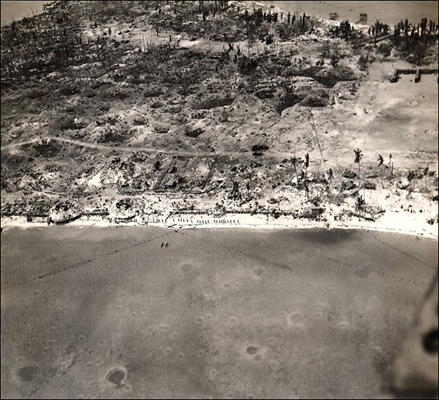
|
|
|
|
|
|
|
|
|
|
|
|
|
|
|
|
|
|
|
|
|
|
|
|
|
|
|
|
|
|
|
|
|
|
|
|
|
|
|
|
|
|
|
|
|
|
|
|
|
|
|
|
|
|
|
|
|
|
|
|
|
|
|
|
|
|
|
|
|
|
|
|
|
|
|
|
|
|
|
|
|
|
|
|
|
|
|
|
|
|
|
|
|
|
|
|
|
|
|
|
|
|
|
|
|
|
|
|
|
|
|
|
|
|
|
|
|
|
|
|
|
|
|
|
|
|
|
|
|
|
|
|
|
|
|
|
|
|
|
|
|
|
|
|
|
|
|
|
|
|
|
|
|
|
|
|
|
|
|
|
|
|
|
|
|
|
|
|
|
|
|
|
|
|
|
|
|
|
|
|
|
|
|
|
|
|
|
|
|
|
|
|
| Western
portion of Betio looking north-northwest |
|
|
|
|
|
|
|
| Orientation:
north from Black Beach on south shore toward the “Bird’s Beak” (left) and
"The Pocket" (right), from 500 feet altitude in a Douglas SBD-5 Dauntless scout-dive bomber |
|
|
|
|
|
|
|
| https://en.wikipedia.org/wiki/File:Tarawa_aerial_view_24_Nov_1943.jpg |
|
|
|
|
|
|
|
|
|
|
|
|
|
|
|
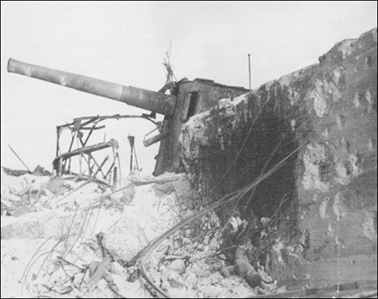
|
|
|
|
|
|
|
|
|
|
|
|
|
|
|
|
|
|
|
|
|
|
|
|
|
|
|
|
|
|
|
|
|
|
|
|
|
|
|
|
|
|
|
|
|
|
|
|
|
|
|
|
|
|
|
|
|
|
|
|
|
|
|
|
|
|
|
|
|
|
|
|
|
|
|
|
|
|
|
|
|
|
|
|
|
|
|
|
|
|
|
|
|
|
|
|
|
|
|
|
|
|
|
|
|
|
|
|
|
|
|
|
|
|
|
|
|
|
|
|
|
|
|
|
|
|
|
|
|
|
|
|
|
|
|
|
| One of
the their 8” guns that gave us trouble until a 16” shell from one of our
battleships silenced it |
|
|
|
|
|
|
|
| http://www.ibiblio.org/hyperwar/USMC/USMC-M-Tarawa/USMC-M-Tarawa-5.html |
|
|
|
|
|
|
|
|
|
|
|
|
|
|
|
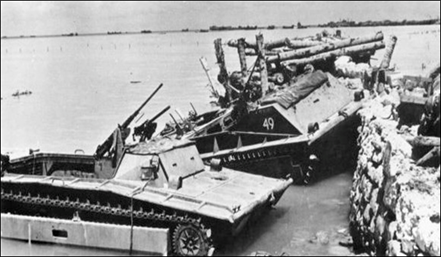
|
|
|
|
|
|
|
|
|
|
|
|
|
|
|
|
|
|
|
|
|
|
|
|
|
|
|
|
|
|
|
|
|
|
|
|
|
|
|
|
|
|
|
|
|
|
|
|
|
|
|
|
|
|
|
|
|
|
|
|
|
|
|
|
|
|
|
|
|
|
|
|
|
|
|
|
|
|
|
|
|
|
|
|
|
|
|
|
|
|
|
|
|
|
|
|
|
|
|
|
|
|
|
|
|
|
|
|
|
|
|
|
|
|
|
|
|
|
|
|
| LVT-1 49 (“My Deloris) the first vehicle to reach Betio's shore, lies in
her final resting place too riddled with shell holes to operate. After the
battle, "My Deloris" was sent to the United States as an exhibit
for War Bond drives and is now at the Tracked Vehicle Museum at Camp Del Mar,
California |
|
|
|
|
|
|
|
| http://www.mca-marines.org/leatherneck/article/bloodiest-beachhead-ever#sthash.x2V6RW1K.dpuf |
|
|
|
|
|
|
|
|
|
|
|
|
|
|
|
| Near
the main command post bunker, a safe had been blasted open, either by
shelling or by some inquisitive Marine.
Strewn around were new twenty-yen notes, which we all stuffed into our
pockets, knowing we were limited to what contraband we were allowed to bring
back. Currency was one item that could
be easily traded off or sold. Word got
around that the safe had contained thousands of dollars in American currency,
but as usual, no one seemed to remember what happened to the money. |
|
|
|
|
|
|
|
|
|
|
|
|
|
|
|
| Marine
defense units arrived on the fourth day (D+3) to relieve the 2nd Marine
Division. We were ordered to move
out. Forming two lines, our platoon
wearily proceeded to the pier and the waiting boats. This time we were allowed to come aboard
the troop transport USS Zeilin (APA-3) by way of the gangway. |
|
|
|
|
|
|
|
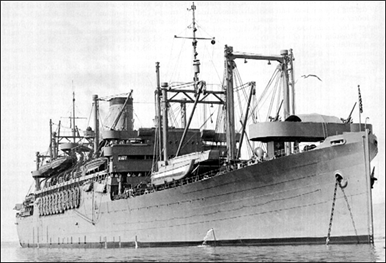
|
|
|
|
|
|
|
|
|
|
|
|
|
|
|
|
|
|
|
|
|
|
|
|
|
|
|
|
|
|
|
|
|
|
|
|
|
|
|
|
|
|
|
|
|
|
|
|
|
|
|
|
|
|
|
|
|
|
|
|
|
|
|
|
|
|
|
|
|
|
|
|
|
|
|
|
|
|
|
|
|
|
|
|
|
|
|
|
|
|
|
|
|
|
|
|
|
|
|
|
|
|
|
|
|
|
|
|
|
|
|
|
|
|
|
|
|
|
|
|
|
|
|
|
|
|
|
|
| USS Zeilin (APA-3) |
|
|
|
|
|
|
|
| http://www.navsource.org/archives/10/03/100300307.jpg |
|
|
|
|
|
|
|
|
|
|
|
|
|
|
|
| We
were a sad-looking lot, looking more like walking zombies with coral dust in
our hair and around our eyes and our clothes torn to ribbons. We were mostly
silent as we boarded. For days we just
sat around on deck thinking of our good fortune and the fate of our Marine
friends we left behind. A familiar
thought came to us all: Why am I still
alive? |
|
|
|
|
|
|
|
|
|
|
|
|
|
|
|
| After
boarding, I held a platoon and roll call.
When we left Tarawa, all the men were notified to have their weapons
with them. Calling the platoon to
attention, I began to walk down the lines.
Automatically, each man snapped his rifle or weapons up for
inspection. Hollywood came to a snappy
“port arms,” and I wasn’t surprised to see that he had a Japanese rifle. With a straight face he reported that his
rifle had been damaged and he had been carrying the Jap rifle around for a
few days, no doubt thinking that if he had brought two rifles aboard, someone
would have questioned him about the Jap rifle. I just couldn’t put this man down,
especially with his ingenuity on top of his being a good Marine. “Be sure to check out another rifle after
we arrive in Hawaii,” I said. |
|
|
|
|
|
|
|
|
|
|
|
|
|
|
|
| The
battle of Tarawa was a hard-won campaign.
The losses were questioned by the press and the public back home, but
when evaluated, seemed to be well within the realm of casualties expected
from a direct amphibious assault against a strongly defended island. The 2nd Marine Division had 3,301 casualties, with 990 being
fatal. Japanese strength the day of
the landing was 4,836 with 129 Korean laborers taken prisoner. Only seventeen Japanese survived and were
captured. Not one of the garrisoned
troops had escaped. After the battle
we were informed that General MacArthur’s bombers carrying thousand-pound
“daisy cutter” bombs, which spew the ground with shrapnel, never arrived
before our landing, adding to our displeasure of “Old Doug-Out-Doug, “ as
MacArthur was fondly called by the Marines. |
|
|
|
|
|
|
|
|
|
|
|
|
|
|
|
| Months
later, back in Hawaii, we were allowed to view censored, vivid, full-color
films of the battle, taken by Marine combat cameramen. Viewing the carnage of bloated and
decimated bodies again brought flash-back memories of the engagement. The film was so clear and vivid (advanced
color film had been used) that many a Marine became nauseated and had chills
(including me). To this day, parts of
that film have never been shown to the public. |
|
|
|
|
|
|
|
|
|
|
|
|
|
|
|
| Meanwhile,
I can always kick back and reflect on what a peaceful end to a peaceful day
must be like nowadays on Betio. For
example, I can only wonder what it might be like to see the sun going down
across the lagoon toward Betio. A warm
breeze, the rustling of palm fronds and, otherwise, sheer quiet. |
|
|
|
|
|
|
|
|
|
|
|
|
|
|
|
| Of
course, most importantly, I would say farewell to my comrades, "Rest in
peace." |
|
|
|
|
|
|
|
|
|
|
|
|
|
|
|
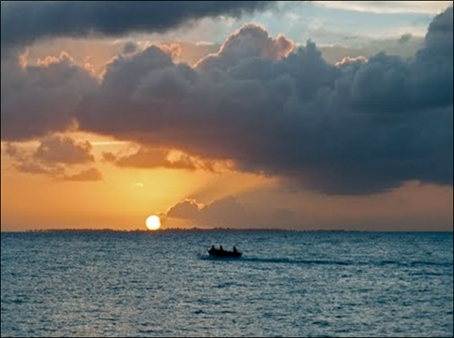
|
|
|
|
|
|
|
|
|
|
|
|
|
|
|
|
|
|
|
|
|
|
|
|
|
|
|
|
|
|
|
|
|
|
|
|
|
|
|
|
|
|
|
|
|
|
|
|
|
|
|
|
|
|
|
|
|
|
|
|
|
|
|
|
|
|
|
|
|
|
|
|
|
|
|
|
|
|
|
|
|
|
|
|
|
|
|
|
|
|
|
|
|
|
|
|
|
|
|
|
|
|
|
|
|
|
|
|
|
|
|
|
|
|
|
|
|
|
|
|
|
|
|
|
|
|
|
|
|
|
|
|
|
|
|
|
|
|
|
|
|
|
|
|
|
|
|
|
|
|
|
|
|
|
|
|
|
|
|
|
| The
sun goes down peacefully over the Red Beaches of Betio. |
|
|
|
|
|
|
|
| http://www.panoramio.com/photo/61611103 |
|
|
|
|
|
|
|
|
|
|
|
|
|
|
|
| With
all the technology available to us these days, different views on Tarawa
exist that were almost unimaginable back in 1943. Take, for example, what our
astronauts these days can see from the confines of their space shuttles in
the cold and quiet of space. |
|
|
|
|
|
|
|
|
|
|
|
|
|
|
|
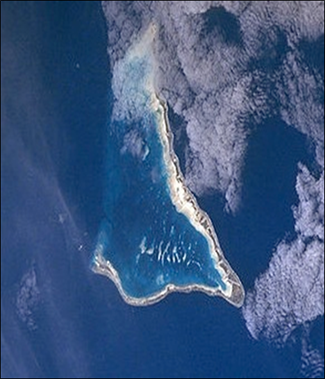
|
|
|
|
|
|
|
|
|
|
|
|
|
|
|
|
|
|
|
|
|
|
|
|
|
|
|
|
|
|
|
|
|
|
|
|
|
|
|
|
|
|
|
|
|
|
|
|
|
|
|
|
|
|
|
|
|
|
|
|
|
|
|
|
|
|
|
|
|
|
|
|
|
|
|
|
|
|
|
|
|
|
|
|
|
|
|
|
|
|
|
|
|
|
|
|
|
|
|
|
|
|
|
|
|
|
|
|
|
|
|
|
|
|
|
|
|
|
|
|
|
|
|
|
|
|
|
|
|
|
|
|
|
|
|
|
|
|
|
|
|
|
|
|
|
|
|
|
|
|
|
|
|
|
|
|
|
|
|
|
|
|
|
|
|
|
|
|
|
|
|
|
|
|
|
|
| Another
peaceful view of Tarawa is from Space Shuttle Endeavor . . . |
|
|
|
|
|
|
|
| from
209 miles in space in December 1998 |
|
|
|
|
|
|
|
| Mission:
STS088 Roll: 707 Frame: 6 |
|
|
|
|
|
|
|
| Image
courtesy of the Image Science & Analysis Laboratory, NASA Johnson Space
Center |
|
|
|
|
|
|
|
| http://eol.jsc.nasa.gov/scripts/sseop/photo.pl?mission=STS088&roll=707&frame=6 |
|
|
|
|
|
|
|
|
|
|
|
|
|
|
|
| The
peaceful image of Tarawa from space is, in some ways, the opposite to the
heat and noise of battle down on Tarawa Atoll. On the other hand, in both images I still
vividly remember friends lost, assault beaches, heat, thirst, hunger, noise,
smells, the anchorages for our transports and the comradeship of buddies whom
I will never forget. Reflecting on
all of that, I reaffirm here and now, just like the title of my book … Once a Marine, Always a Marine. Semper Fi, Brothers! |
|
|
|
|
|
|
|
|
|
|
|
|
|
|
|
| So,
with the battle for Tarawa now behind me, my unit and I were sent to Camp
Tarawa on the Big Island of Hawaii, but first we went to Honolulu. The convoy
made a short stopover to evacuate wounded and to allow us a few hours ashore
to stretch our legs. Being familiar
with the base and knowing where the slop chute (post exchange bar) was, I
suggested to a buddy that we could get to the other side of the base, grab a
few beers, and be back before our ship’s departure. We hitched a ride right up to the slop
chute door and began downing beers like a couple of camels just off the
desert. Time slipped by; we had gone
past just quenching our thirst. We
headed back to the docks and to our surprise, not a ship was tied up. They had all hauled ass, heading down the
channel in single file. Our transport
was slowly turning to follow the convoy. |
|
|
|
|
|
|
|
|
|
|
|
|
|
|
|
| Our
first thought: We are both AWOL and
will be court-martialed, followed by, How can we get aboard? It was a sad situation. I jammed my hands in my pockets, pockets
stuffed with the new, Japanese twenty-yen notes. Noting a sailor working on a motor launch
on the dock, I asked, “Will you take some Jap money for a ride to our ship?” The sailor was hesitant, until I mentioned
its souvenir value. “Hop in,” he
said. “You got a deal.” |
|
|
|
|
|
|
|
|
|
|
|
|
|
|
|
| Marines
lining the rail cheered us on as our boat, churning the water, finally
equaled the speed of the ship and pulled up under the last landing net still
draped over the side. There were
whistles and cheers as we grabbed the net and climbed aboard, even as
deckhands continued to haul in the net.
A few minutes later, as we headed aft, my first lieutenant stopped me
and said, “Say Mike, I’d swear that one of those Marines who just climbed
aboard looked just like you.” I smiled
and replied, “Is that right, Sir?” and continued below deck. |
|
|
|
|
|
|
|
|
|
|
|
|
|
|
|
| We
finally got to Hilo (on the northeast coast of Hawaii, under cloud cover in
the following photo). The entire 2nd Marine Division was
encamped at a new camp appropriately called Camp Tarawa, on the sprawling
Parker Ranch land situated between the two peaks of Mauna Kea (13,803’
altitude) and Mauna Loa (13,769’ altitude). |
|
|
|
|
|
|
|
|
|
|
|
|
|
|
|
| There
may have been swimming on the beaches, but at our 10,000-foot elevation the
weather was even cooler than anticipated for the month of December. Snow was visible on the two peaks; although
it was warmer when the sun shone, the nights were cold enough for ice to form
on puddles of water. |
|
|
|
|
|
|
|
|
|
|
|
|
|
|
|
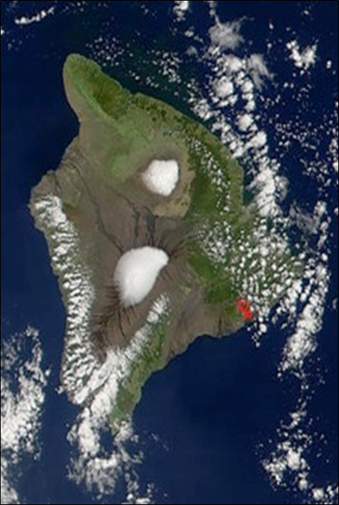
|
|
|
|
|
|
|
|
|
|
|
|
|
|
|
|
|
|
|
|
|
|
|
|
|
|
|
|
|
|
|
|
|
|
|
|
|
|
|
|
|
|
|
|
|
|
|
|
|
|
|
|
|
|
|
|
|
|
|
|
|
|
|
|
|
|
|
|
|
|
|
|
|
|
|
|
|
|
|
|
|
|
|
|
|
|
|
|
|
|
|
|
|
|
|
|
|
|
|
|
|
|
|
|
|
|
|
|
|
|
|
|
|
|
|
|
|
|
|
|
|
|
|
|
|
|
|
|
|
|
|
|
|
|
|
|
|
|
|
|
|
|
|
|
|
|
|
|
|
|
|
|
|
|
|
|
|
|
|
|
|
|
|
|
|
|
|
|
|
|
|
|
|
|
|
|
|
|
|
|
|
|
|
|
|
|
|
|
|
|
|
|
|
|
|
|
|
|
|
|
|
|
|
|
|
|
|
|
|
|
|
|
|
|
|
|
|
|
|
|
|
|
|
|
|
|
|
|
|
|
|
|
|
|
|
|
|
|
|
|
| Mauna
Kea (upper large white area) and Mauna Loa (lower larger white area) |
|
|
|
|
|
|
|
| Camp
Tarawa is located in the large valley between the two peaks on the Big Island
of Hawaii. |
|
|
|
|
|
|
|
| Source:
eoimages.gsfc.nasa.gov Hawaii.A2002059.2055.500m.jpg |
|
|
|
|
|
|
|
|
|
|
|
|
|
|
|
| The
top brass decided that the cooler climate would arrest the remainder of
malaria cases still hanging on from Guadalcanal. The Parker Ranch was the most isolated
location for a camp--ideal to train and prime the Marines for their next
landing. All we found were wood
platforms and stacks of canvas tents; nothing had been erected. For the next two weeks Marines turned to,
still in light tropical fatiques, putting the camp together. Jackets and blankets were in short supply
until our personal sea bags arrived.
In the meantime, the Army was reluctantly “lending” us some blankets. |
|
|
|
|
|
|
|
|
|
|
|
|
|
|
|
| Our
company fared better. We were
temporarily detached from the division and were stationed a few miles from
Hilo to unload transports at the docks.
Several ships had not been combat-loaded (in an orderly manner) in
Wellington, as they thought our November 1943 departure was just for a
training exercise. These ships were
not unloaded at Betio, which left one big mess to unload at Hilo. Seasonal rains turned many of the
unprotected items into heaps of rubbish, which were skip-loaded onto trucks. |
|
|
|
|
|
|
|
|
|
|
|
|
|
|
|
| We
were pleased to hear about being billeted near Hilo, but we had second
thoughts upon entering our camp.
Originally designed to be a Japanese prisoner of war camp, then
condemned as unfit for the Japs, it now was supposedly suitable for
Marines. Biuilt on lava mounds up to
five feet high, the only level spots in the camp were the company office,
mess hall, and road leading into camp.
The shining mounds were slippery and difficult to pass between even
during dry weather, so imagine how theh were traversed under the influence of
a few beers! Tents were at different
elevations over mounds that were not lined up, with the main street looking
like an anthill obstacle course. |
|
|
|
|
|
|
|
|
|
|
|
|
|
|
|
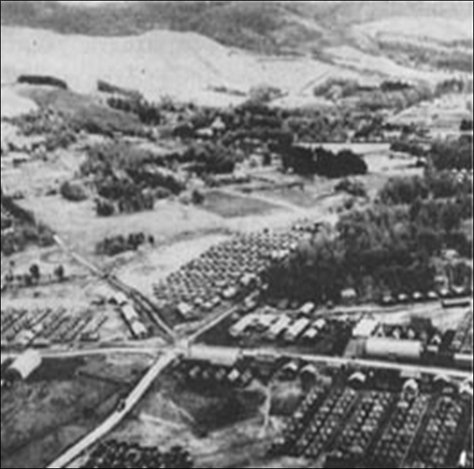
|
|
|
|
|
|
|
|
|
|
|
|
|
|
|
|
|
|
|
|
|
|
|
|
|
|
|
|
|
|
|
|
|
|
|
|
|
|
|
|
|
|
|
|
|
|
|
|
|
|
|
|
|
|
|
|
|
|
|
|
|
|
|
|
|
|
|
|
|
|
|
|
|
|
|
|
|
|
|
|
|
|
|
|
|
|
|
|
|
|
|
|
|
|
|
|
|
|
|
|
|
|
|
|
|
|
|
|
|
|
|
|
|
|
|
|
|
|
|
|
|
|
|
|
|
|
|
|
|
|
|
|
|
|
|
|
|
|
|
|
|
|
|
|
|
|
|
|
|
|
|
|
|
|
|
|
|
|
|
|
|
|
|
|
|
|
|
|
|
|
|
|
|
|
|
|
|
|
|
|
|
|
|
|
|
|
|
|
|
|
|
|
|
|
|
|
|
|
|
|
|
|
|
|
|
|
|
|
|
|
|
|
|
|
|
|
|
|
|
|
|
|
|
|
| Camp
Tarawa, Parker Ranch, Big Island of Hawaii |
|
|
|
|
|
|
|
| http://www.waimeagazette.com/Mar95_WaimeaRemembersTarawa.htm |
|
|
|
|
|
|
|
|
|
|
|
|
|
|
|
| A
strange notice was posted on the company bulletin board: “Souvenirs (minus
any live ammunition) will be allowed to be shipped home, up to 200 lbs,
free.” None of us could believe it. We were never allowed to carry out
contraband equipment, unless it was a Jap pistol, Samurai sword, or
flags. Even if we did, we had to
dispose of it in the rear areas by selling it to sailors. |
|
|
|
|
|
|
|
|
|
|
|
|
|
|
|
| If
the notice was a surprise, a bigger surprise was when two Marines came
walking down the company street carrying a Japanese heavy Nambu machine gun.
It was boxed up, mailed, and no questions asked! We questioned, “How did he bring it ashore
and keep it concealed? Good thing no
one showed up with a light Jap tank! |
|
|
|
|
|
|
|
|
|
|
|
|
|
|
|
| The
company returned to Camp Tarawa with the rest of the division. Life there, though, wasn’t all work and no
play! I remember the rodeo. |
|
|
|
|
|
|
|
|
|
|
|
|
|
|
|
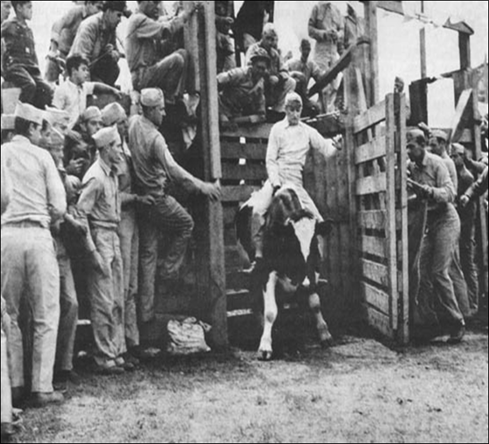
|
|
|
|
|
|
|
|
|
|
|
|
|
|
|
|
|
|
|
|
|
|
|
|
|
|
|
|
|
|
|
|
|
|
|
|
|
|
|
|
|
|
|
|
|
|
|
|
|
|
|
|
|
|
|
|
|
|
|
|
|
|
|
|
|
|
|
|
|
|
|
|
|
|
|
|
|
|
|
|
|
|
|
|
|
|
|
|
|
|
|
|
|
|
|
|
|
|
|
|
|
|
|
|
|
|
|
|
|
|
|
|
|
|
|
|
|
|
|
|
|
|
|
|
|
|
|
|
|
|
|
|
|
|
|
|
|
|
|
|
|
|
|
|
|
|
|
|
|
|
|
|
|
|
|
|
|
|
|
|
|
|
|
|
|
|
|
|
|
|
|
|
|
|
|
|
|
|
|
|
|
|
|
|
|
|
|
|
|
|
|
|
|
|
|
|
|
|
|
|
| The
rodeo and barbecue on the Parker Ranch was good for moral purposes. |
|
|
|
|
|
|
|
| http://www.waimeagazette.com/Mar95_WaimeaRemembersTarawa.htm |
|
|
|
|
|
|
|
|
|
|
|
|
|
|
|
| After
all, Camp Tarawa was located on one of the largest cattle ranches in the
world, and they donated steers, and the division supplied cowboys to ride the
bucking steers. |
|
|
|
|
|
|
|
|
|
|
|
|
|
|
|
| A
U.S.O. group provided entertainment, plus we had a limit of two cans of U.S.
beer each. As usual, though, chiselers
were continuously cutting in front of the line and hoarding the beer,
preventing others from getting their allotment. On the second day of beer rationing, I was
assigned as Sergeant of the Guard, but before going on duty, I was asked to
attend with other NCOs a stern lecture on the beer problem by a “boot” platoon
sergeant, as the old salts called him (he came straight out of boot amp when
we formed in San Diego, clerked in the company office, always remained with
the rear echelon along with our records and somehow received automatic
promotions). |
|
|
|
|
|
|
|
|
|
|
|
|
|
|
|
| Back
to the beer…that afternoon while on watch, one of the guards on the beer
detail came running up to me. “Hey
Sarge, guess who just chiseled in the beer line, along with a few of his
friends? The boot sarge!” The sentry, a replacement private, was in a
spot and didn’t know how to handle the situation to carry out his
orders. Naturally, it was up to me to
do something about it. Proceeding to
the front of the line, I tapped the boot sarge on the shoulder and, with my
finger, pointed “Out” to him and his friends.
He looked surprised and indignant but knew I was following his
orders. Knowing that I was determined
and that all the men in the line were waiting to see if he was going to pull
rank on me, he and his friends left the line, grumbling as they
departed. Spontaneously the entire
beer line burst into cheers and applause.
I had lost points with him, but I felt my integrity with the men was
more important. |
|
|
|
|
|
|
|
|
|
|
|
|
|
|
|
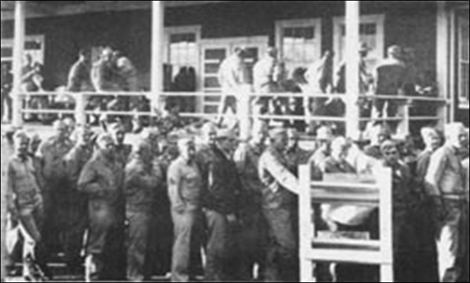
|
|
|
|
|
|
|
|
|
|
|
|
|
|
|
|
|
|
|
|
|
|
|
|
|
|
|
|
|
|
|
|
|
|
|
|
|
|
|
|
|
|
|
|
|
|
|
|
|
|
|
|
|
|
|
|
|
|
|
|
|
|
|
|
|
|
|
|
|
|
|
|
|
|
|
|
|
|
|
|
|
|
|
|
|
|
|
|
|
|
|
|
|
|
|
|
|
|
|
|
|
|
|
|
|
|
|
|
|
|
|
|
|
|
|
|
|
|
|
|
|
|
|
|
|
|
|
|
|
|
|
|
|
|
|
|
| A
line-up for some attraction at Camp Tarawa!
Beer? |
|
|
|
|
|
|
|
| http://www.waimeagazette.com/Mar95_WaimeaRemembersTarawa.htm |
|
|
|
|
|
|
|
|
|
|
|
|
|
|
|
| I
remember, too, a serious case of mistaken identity at Camp Tarawa. The islanders on the Big Island were
Hawaiian or of oriental descent. Some
Marines still could not distinguish between the Japs of Guadalcanal and
Tarawa with these oriental islanders.
Dating or even speaking to the few Japanese girls in Hilo was also
difficult. It was just as well, as
Marines had acquired a deep hatred for anybody that looked Japanese. |
|
|
|
|
|
|
|
|
|
|
|
|
|
|
|
| Hilo
was an hour’s ride away over a poor dirt road. The town couldn’t even hold more than two
companies of Marines on liberty. An
alternative was to send small groups for short periods to local towns like
Kamuela. One Marine, still psyched by
the fierce fighting on Tarawa, still in a state of combat fatigue, went into
Kamuela for a haircut. The barbershop was a combination store – gas station
and barber shop – operated by a Japanese-American couple. The wife had completed the haircut. As she went out to gas a car, her husband
lathered the Marine’s face for the final trim. At this point something was triggered in
the Marine’s mind, and he allegedly killed the barber. Combat fatigue, as we called it, affected
each of us in different ways. I can
now understand why, upon returning to the States, the brass gave us a short
stay at the San Diego Marine Base before allowing us to go home on leave. |
|
|
|
|
|
|
|
|
|
|
|
|
|
|
|
| Camp
Tarawa was also the training ground for the next campaign. The vast maneuver space below Mauna Kea was
already being used and new replacements were being molded into fighting
units. With thousands of men,
equipment, and planes in a combat exercise of this magnitude and using live
ammunition to simulate actual conditions, accidents were expected. There were injuries and some fatalities due
to close support strafing aircraft firing too close to forward elements. |
|
|
|
|
|
|
|
|
|
|
|
|
|
|
|
| With
dress rehearsals completed and logistics worked out, orders were issued to
all units. Our platoon again was
assigned the mission of coordinating the movement of supplies ashore in our
respective battalion beachheads, because of experience gained on previous
campaigns. And lucky me, as a
reconnaissance NCO, two assistants and I were again going in with the third
assault wave at what turned out to be Saipan (Operation Forager), a little
over 3,700 miles west of Honolulu, in the Marianas. All of that, though, is another story. |
|
|
|
|
|
|
|
|
|
|
|
|
|
|
|
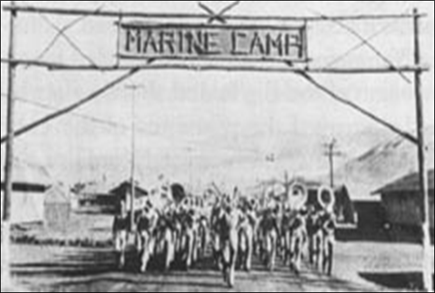
|
|
|
|
|
|
|
|
|
|
|
|
|
|
|
|
|
|
|
|
|
|
|
|
|
|
|
|
|
|
|
|
|
|
|
|
|
|
|
|
|
|
|
|
|
|
|
|
|
|
|
|
|
|
|
|
|
|
|
|
|
|
|
|
|
|
|
|
|
|
|
|
|
|
|
|
|
|
|
|
|
|
|
|
|
|
|
|
|
|
|
|
|
|
|
|
|
|
|
|
|
|
|
|
|
|
|
|
|
|
|
|
|
|
|
|
|
|
|
|
|
|
|
|
|
|
|
|
|
|
|
|
|
|
|
|
| Daily
march of the Camp Tarawa Marine Band through Waimea |
|
|
|
|
|
|
|
| http://www.waimeagazette.com/Mar95_WaimeaRemembersTarawa.htm |
|
|
|
|
|
|
|
|
|
|
|
|
|
|
|
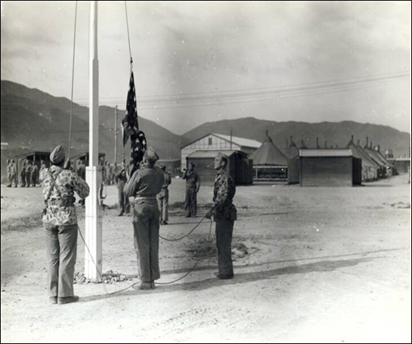
|
|
|
|
|
|
|
|
|
|
|
|
|
|
|
|
|
|
|
|
|
|
|
|
|
|
|
|
|
|
|
|
|
|
|
|
|
|
|
|
|
|
|
|
|
|
|
|
|
|
|
|
|
|
|
|
|
|
|
|
|
|
|
|
|
|
|
|
|
|
|
|
|
|
|
|
|
|
|
|
|
|
|
|
|
|
|
|
|
|
|
|
|
|
|
|
|
|
|
|
|
|
|
|
|
|
|
|
|
|
|
|
|
|
|
|
|
|
|
|
|
|
|
|
|
|
|
|
|
|
|
|
|
|
|
|
|
|
|
|
|
|
|
|
|
|
|
|
|
|
|
|
|
|
|
|
|
|
|
|
| Morning
colors 2nd Marine Division – Camp Tarawa, 1944 |
|
|
|
|
|
|
|
| http://www.camptarawamcl.com/ |
|
|
|
|
|
|
|
|
|
|
|
|
|
|
|
| I
understand that Camp Tarawa still lives!
Camp Tarawa Detachment #1255 of the Marine Corps League (MCL) exists
to honor and perpetuate the history of the 55,000 men of the 2nd and 5th Marine Divisions and
the Navy Corpsmen and Seabees who trained at old Camp Tarawa between December
1943 and November 1945. Of these men,
a total of 5,145 were killed in action or died of their wounds. |
|
|
|
|
|
|
|
|
|
|
|
|
|
|
|
| The
dedicated staff of Camp Tarawa Detachment #1255, through The Camp Tarawa
Foundation, collaborate for charitable, literary and educational purposes,
including fund raising for the construction of the new nearly 20,000 square
foot Camp Tarawa Museum and Educational Center. |
|
|
|
|
|
|
|
| http://www.camptarawamcl.com/ |
|
|
|
|
|
|
|
|
|
|
|
|
|
|
|
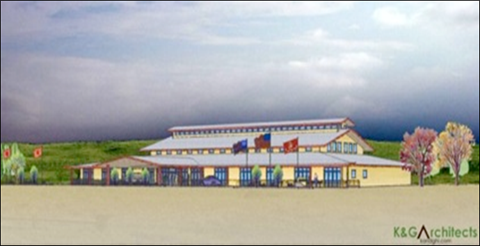
|
|
|
|
|
|
|
|
|
|
|
|
|
|
|
|
|
|
|
|
|
|
|
|
|
|
|
|
|
|
|
|
|
|
|
|
|
|
|
|
|
|
|
|
|
|
|
|
|
|
|
|
|
|
|
|
|
|
|
|
|
|
|
|
|
|
|
|
|
|
|
|
|
|
|
|
|
|
|
|
|
|
|
|
|
|
|
|
|
|
|
|
|
|
|
|
|
|
|
|
|
|
|
|
|
|
|
|
|
|
|
|
|
|
|
|
|
|
|
|
| Visitors
are welcome! Tours of about 3 hours in
length are conducted around the 42,000 acres that made up the Waikoloa
Maneuver ranges to view the site of the proposed Camp Tarawa
Museum-Educational Center and to a viewing site at 2,500 feet in elevation
where guests can enjoy a spectacular look out over the entire area. The tours continue to the Camp Tarawa
Memorial Monument, the Parker Ranch and the town of Waimea, the Waimea County
Park (where the baseball field and parade ground were located) and on to a
quick look at Buster Brown (the hill Marines climbed every day in preparation
for the assault on Mt. Suribachi on Iwo Jima). And finally, the tours
continue to the National Park Service Pu’ukohola National Historic site for a
moving PowerPoint slide show, before going to the Hapuna State Beach and old
Camp Drewes where the Amtracs were based and the Snipers and Scouts trained
in rubber boats. |
|
|
|
|
|
|
|
| http://www.camptarawamcl.com/contact.html |
|
|
|
|
|
|
|
|
|
|
|
|
|
|
|
|
|
|
|
|
|
|
|
| Medals
earned during World War II include: |
|
|
|
|
|
|
|
|
|
|
|
|
|
|
|
| (1)
Purple Heart (2) WW II Victory (3) Marine Corps Good Conduct |
|
|
|
|
|
|
|
|
|
|
|
|
|
|
|
|
| |
|
|
|
|
|
|
|
| |
|
|
|
|
|
|
|
|
|
|
|
|
|
|
|
|
|
|
|
|
|
|
|
|
|
|
|
|
|
|
|
|
|
|
|
|
|
|
|
|
|
|
|
|
|
|
|
|
|
|
|
|
|
|
|
|
|
|
|
|
|
|
|
| (4) Asiatic-Pacific Campaign (5) American Defense Service |
|
|
|
|
|
|
|
|
|
|
|
|
|
|
|
|
| |
|
|
|
|
|
|
|
| |
|
|
|
|
|
|
|
|
|
|
|
|
|
|
|
|
|
|
|
|
|
|
|
|
|
|
|
|
|
|
|
|
|
|
|
|
|
|
|
|
|
|
|
|
|
|
|
|
|
|
|
|
|
|
|
|
|
|
|
|
|
|
|
|
|
|
|
|
|
|
|
|
|
|
|
|
|
|
|
|
|
|
|
|
|
|
|
|
|
|
|
|
|
|
|
|
|
|
|
|
|
|
|
|
|
|
|
|
|
|
|
|
|
|
|
|
|
|
|
| (6) PRESIDENTIAL UNIT CITATION (Guadalcanal) |
|
|
|
|
|
|
|

|
|
|
|
|
|
|
|
|
|
|
|
|
|
|
|
| OPERATION WATCHTOWER |
|
|
|
|
|
|
|
| GUADALCANAL OPERATION |
|
|
|
|
|
|
|
|
|
|
|
|
|
|
|
|
|
|
|
|
|
|
|
|
|
|
|
|
|
|
|
| 4-Feb-43 |
|
|
|
|
|
|
|
|
|
|
|
|
|
|
|
|
|
|
|
|
|
|
|
| Cited
in the Name of the President of the United States |
|
|
|
|
|
|
|
|
|
|
|
|
|
|
|
|
|
|
|
|
|
|
|
| THE FIRST
MARINE DIVISION (REINFORCED) |
|
|
|
|
|
|
|
|
|
|
|
|
|
|
|
|
|
|
|
|
|
|
|
| Under
command of Major General Alexander A. Vandegrift, USMC |
|
|
|
|
|
|
|
|
|
|
|
|
|
|
|
|
|
|
|
|
|
|
|
| CITATION: |
|
|
|
|
|
|
|
|
|
|
|
|
|
|
|
|
|
|
|
|
|
|
|
| "The
officers and enlisted men of the First Marine Division, Reinforced, on August
7 to 9, 1942, demonstrated outstanding gallantry and determination in
successfully executing forced landing assaults against a number of strongly
defended Japanese positions on Tulagi, Gavutu, Tanambogo, Florida and
Guadalcanal, British Solomon Islands, completely routing all enemy forces and
seizing a most valuable base and airfield within the enemy zone of operations
in the South Pacific Ocean. From the above period until 9 December 1942, this
Reinforced Division not only held their important strategic positions despite
determined and repeated Japanese naval, air and land attacks, but in a series
of offensive operations against strong enemy resistance drove the Japanese
from the proximity of the airfield and inflicted great losses on them by land
and air attacks. The courage and determination displayed in these operations
were of an inspiring order." |
|
|
|
|
|
|
|
|
|
|
|
|
|
|
|
| Frank
Knox |
|
|
|
|
|
|
|
| Secretary
of the Navy |
|
|
|
|
|
|
|
| http://www.ww2gyrene.org/spotlight_2ndmardiv_awards.htm#DIVISION |
|
|
|
|
|
|
|
|
|
|
|
|
|
|
|
|
|
|
|
|
|
|
|
|
|
|
|
|
|
|
|
|
|
|
|
|
|
|
|
|
|
|
|
|
|
|
|
|
|
|
|
|
|
|
|
|
|
|
|
|
|
|
|

| (7) PRESIDENTIAL UNIT CITATION (Tarawa) |
|
|
|
|
|
|
|
|
|
|
|
|
|
|
|
|
|
|
|
|
|
|
|
|
| OPERATION GALVANIC |
|
|
|
|
|
|
|
| ASSAULT AND
CAPTURE OF TARAWA |
|
|
|
|
|
|
|
|
|
|
|
|
|
|
|
|
|
|
|
|
|
|
|
|
|
|
|
|
|
|
|
| The
President of the United States takes pleasure in presenting the |
|
|
|
|
|
|
|
|
|
|
|
|
|
|
|
| PRESIDENTIAL UNIT
CITATION |
|
|
|
|
|
|
|
|
|
|
|
|
|
|
|
| to the |
|
|
|
|
|
|
|
|
|
|
|
|
|
|
|
|
|
|
|
|
|
|
|
| SECOND MARINE
DIVISION, REINFORCED |
|
|
|
|
|
|
|
|
|
|
|
|
|
|
|
| consisting
of Division Headquarters, Special Troops (including Company C, 1st Corps
Medium Tank Battalion), Service Troops, 2nd, 6th, 8th, 10th and 18th Marine
Regiments in the Battle of Tarawa, |
|
|
|
|
|
|
|
|
|
|
|
|
|
|
|
|
|
|
|
|
|
|
|
| "For
outstanding performance in combat during the seizure and occupation of the
Japanese-held Atoll of Tarawa, Gilbert Islands, November 20 to 24, 1943.
Forced by the treacherous coral reefs to disembark from their landing craft
hundreds of yards off the beach, the Second Marine Division (Reinforced)
became a highly vulnerable target for devastating Japanese fire. Dauntlessly
advancing in spite of rapidly mounting losses, the Marines fought a gallant
battle against crushing odds, clearing the limited beachheads of snipers and
machine guns, reducing powerfully fortified enemy positions and completely
annihilating the fanatically determined and strongly entrenched Japanese
forces. By the successful occupation of Tarawa, the Second Marine Division (Reinforced)
has provided our forces with highly strategic and important air and land
bases from which to continue future operations against the enemy; by the
valiant fighting spirit of these men, their heroic fortitude under punishing
fire and their relentless perseverance in waging this epic battle in the
Central Pacific, they have upheld the finest traditions of the United States
Naval Service." |
|
|
|
|
|
|
|
|
|
|
|
|
|
|
|
| For
the President |
|
|
|
|
|
|
|
|
|
|
|
|
|
|
|
| JAMES
FORRESTAL |
|
|
|
|
|
|
|
| Secretary
of the Navy |
|
|
|
|
|
|
|
| http://www.ww2gyrene.org/spotlight_2ndmardiv_awards.htm#tarawa |
|
|
|
|
|
|
|
|
|
|
|
|
|
|
|
|
|
|
|
|
|
|
|
|
|
|
|
|
|
|
|
|
|
|
|
|
|
|
|
|
|
|
|
|
|
|
|
|
|
|
|
|
|
|
|
| SARGE, STAND
TALL! WELL DONE! |
|
|
|
|
|
|
|
|
|
|
|
|
|
|
|
|
|
|
|
|
|
|
|
| You
will always be a Marine, and you are justifiably proud of that. And we are proud of you. At age 89, you clearly show the same
inextinguishable spirit and energy as when you joined the Marine Corps at age
17 in 1939. Your example of service to
our country inspires others to follow.
Thank you for your permission to use selected passages from Once a Marine, Always a Marine
(1988) as the basis for this report.
We thank you for your service, and we will remember. |
|
|
|
|
|
|
|
|
|
|
|
|
|
|
|
|
|
|
|
|
|
|
|
| SEMPER FI,
MIKE! |
|
|
|
|
|
|
|
|
|
|
|
|
|
|
|
|
|
|
|
|
|
|
|
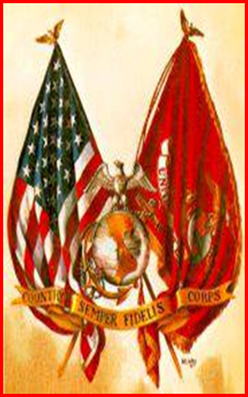
|
|
|
|
|
|
|
|
|
|
|
|
|
|
|
|
|
|
|
|
|
|
|
|
|
|
|
|
|
|
|
|
|
|
|
|
|
|
|
|
|
|
|
|
|
|
|
|
|
|
|
|
|
|
|
|
|
|
|
|
|
|
|
|
|
|
|
|
|
|
|
|
|
|
|
|
|
|
|
|
|
|
|
|
|
|
|
|
|
|
|
|
|
|
|
|
|
|
|
|
|
|
|
|
|
|
|
|
|
|
|
|
|
|
|
|
|
|
|
|
|
|
|
|
|
|
|
|
|
|
|
|
|
|
|
|
|
|
|
|
|
|
|
|
|
|
|
|
|
|
|
|
|
|
|
|
|
|
|
|
|
|
|
|
|
|
|
|
| Received 9 August 2012, updated 13 November 2013 |
|
|
|
|
|
|
|
|
|
|
|
|
|
|
|
| Return to ROSTER |
|
|
|
|
|
|
|
|
|
|
|
|
|
|
|
|
|
|
|
|
|
|
|
|
|
|
|
|
|
|
|
|
|
|
|
|
|
|
|
|
|
|
|
|
|
|
|
|
|
|
|
|
|
|
|
|
|
|
|
|
|
|
|
|
|
|
|
|
|
|
|
|
|
|
|
|
|
|
|
|
|
|
|
|
|
|
|
|
|
|
|
|
|
|
|
























